Mackay, situated in the central coastal region of Queensland, Australia, is a haven for bird enthusiasts. The city boasts a diverse range of bird species, from migratory birds that visit during the summer, to year-round residents, that come in all shapes and sizes.
Home to various habitats, from mangroves and wetlands to forests and grasslands, Mackay offers abundant bird-watching opportunities.
Birdwatchers flock to Mackay to observe exotic and rare species such as the Eastern Grass Owl, Brilliant Fairy Wren, and the Mangrove Honeyeater.
With a moderate climate and stunning natural landscapes, Mackay provides an ideal setting for birds to thrive, making it a must-visit destination for bird lovers.
1. Cotton Pygmy Goose
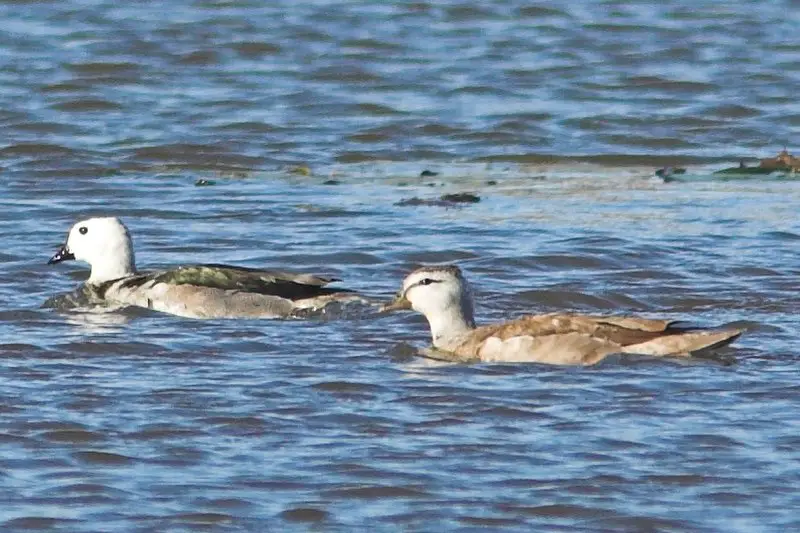
The Cotton Pygmy Goose is a small perching duck found throughout Asia and Southeast Asia, extending south to Queensland.
It stands out among waterfowl as one of the smallest in the world, with a quill-white coloration that helps it blend into its environment.
They often live alone or in pairs but form larger groups when looking for food near bodies of water with plenty of aquatic vegetation.
These birds are omnivorous, feeding on plants like grasses and seeds alongside insects such as beetles and termites.
Their diet also includes fish eggs and larvae from time to time. The cotton pygmies’ size makes them an easy target for predators so they use their agility to quickly escape danger whenever possible.
Scientific classification:
| Kingdom | Animalia |
| Phylum | Chordata |
| Class | Aves |
| Order | Anseriformes |
| Family | Anatidae |
| Genus | Nettapus |
| Species | N. coromandelianus |
Also Featured In: Most Common Birds in China, Common Birds in Kerala
2. Lesser Crested Tern
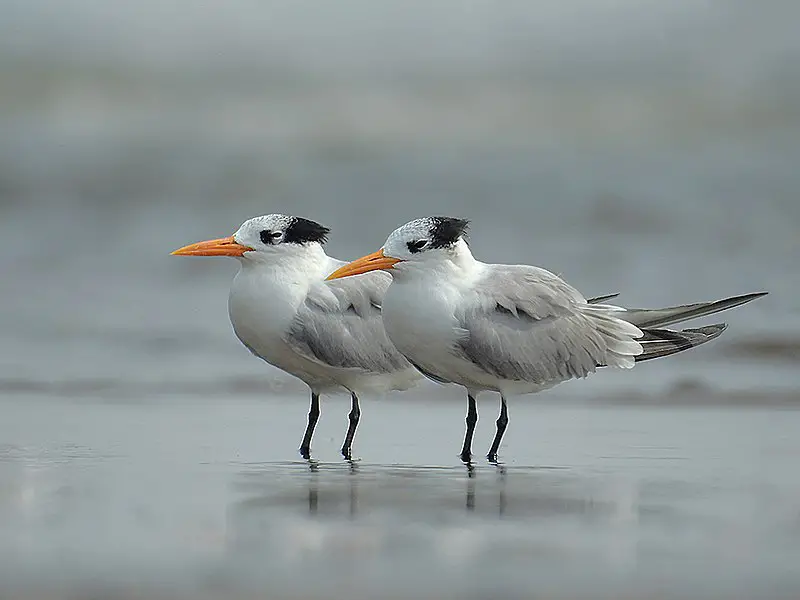
The lesser crested tern is a beautiful bird belonging to the Laridae family. It can be found breeding in subtropical coastal parts of the world, mainly from Red Sea across Indian Ocean.
Its genus name comes from Ancient Greek word Thalasseus which means fisherman and its specific bengalensis refers to Bengal, historically referring to much of northern India and Bangladesh.
The adult has white plumage with grey on wings and back; black cap extending behind eye; long pointed bill yellow tipped red at base, orange legs and feet.
They feed primarily by plunge-diving for fish near shore but may also take some insects or scavenge off boats or piers when given opportunity.
This species nests in colonies often on beaches or islands with other seabirds where it lays two eggs per clutch that are incubated for about a month before hatching.
Scientific classification:
| Kingdom | Animalia |
| Phylum | Chordata |
| Class | Aves |
| Order | Charadriiformes |
| Family | Laridae |
| Genus | Thalasseus |
| Species | T. bengalensis |
Also Featured In: Beautiful Indonesian Birds, Common Birds of Maharashtra
3. Pheasant Coucal
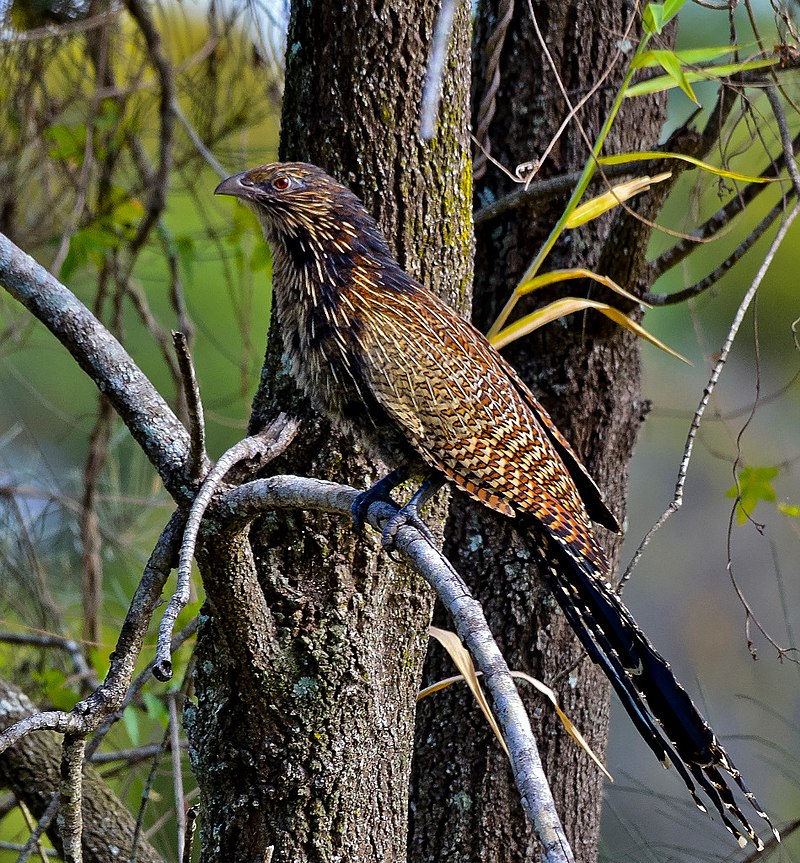
The Pheasant Coucal is a species of cuckoo native to Australia, Timor and New Guinea.
It can be found in subtropical or tropical moist lowland forests as well as mangrove forests but has also adapted well to agricultural areas such as cane fields in Northern Australia.
This makes it an unusual bird among the Australian cuckoos since unlike most other birds from this family, it doesn’t rely on its hosts for incubation and raising offsprings – instead, it does all that by itself.
The female typically lays three eggs which are oval-shaped with light blue colouring that fades over time.
Pheasant coucals have dark brown feathers with some lighter markings around their necks and wings making them look quite unique compared to other birds within the same family.
Scientific classification:
| Kingdom | Animalia |
| Phylum | Chordata |
| Class | Aves |
| Order | Cuculiformes |
| Family | Cuculidae |
| Genus | Centropus |
| Species | C. phasianinus |
Also Featured In: Most common birds in Australia,
4. Orange-Footed Scrubfowl

The Orange-footed Scrubfowl is a small Megapode of the family Megapodiidae found in several islands from Lesser Sunda Islands to southern New Guinea and northern Australia.
It has a dark brown coloration with bright orange legs and feet that stand out against its body, making it quite an eye-catching species.
The bird’s size is roughly equal to that of a domestic chicken.
This species feeds mainly on insects, fruits, seeds and roots but will also scavenge for carrion or feed on worms when available.
They are typically solitary birds except during breeding season when they tend to form colonies near their nesting sites usually along beaches or sand dunes where they can use the heat generated by the sun reflecting off the sand in order to incubate their eggs without having build nests themselves.
Overall this unique bird stands apart from other members of its family due to its striking plumage as well as being one of few ground dwelling megapodes instead of tree dwellers like most others within this group which makes them relatively easy to spot among greenery if you know what you’re looking for.
Scientific classification:
| Kingdom | Animalia |
| Phylum | Chordata |
| Class | Aves |
| Order | Galliformes |
| Family | Megapodiidae |
| Genus | Megapodius |
| Species | M. reinwardt |
5. Bush Stone-Curlew
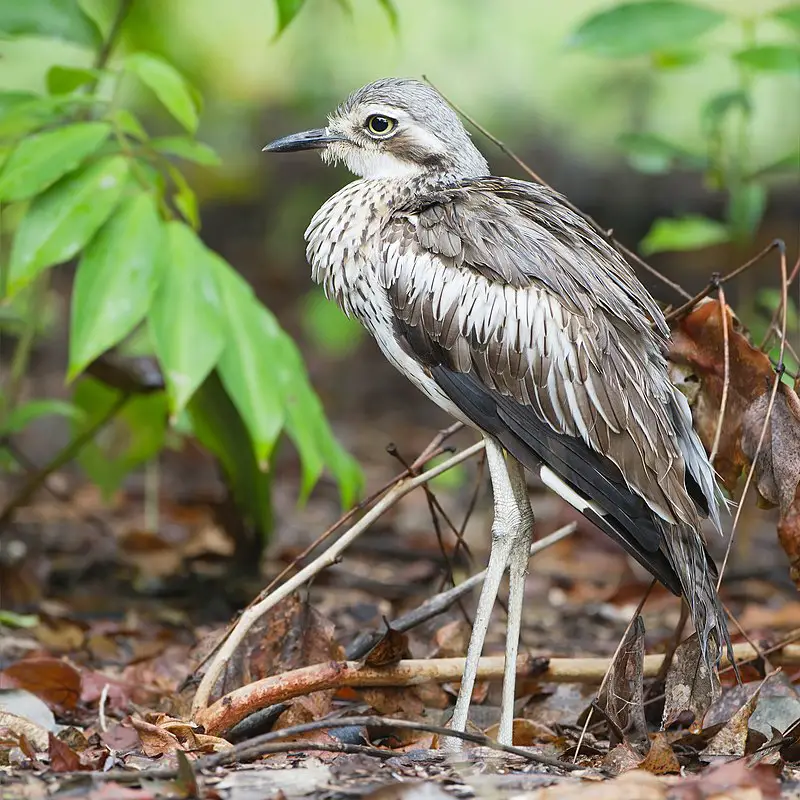
The Bush Stone-Curlew, also known as the Iben Bird, is an endemic species of Australia found in open plains and woodlands. It has grey-brown coloration with dark streaks and large eyes, making it easy to identify.
During night time this bird looks for invertebrates such as insects by slowly stalking its prey. Its long legs allow it to easily traverse across vast landscapes while hunting for food.
The Bush Stone-Curlew plays a vital role in maintaining balance within the ecosystem through controlling insect population growth which can be damaging if not monitored carefully.
Unfortunately due to human interference this species has become endangered so all efforts should be made towards conserving them before they are lost forever from our planet’s biodiversity.
Scientific classification:
| Kingdom | Animalia |
| Phylum | Chordata |
| Class | Aves |
| Order | Charadriiformes |
| Family | Burhinidae |
| Genus | Burhinus |
| Species | B. grallarius |
6. Rose-Crowned Fruit Dove
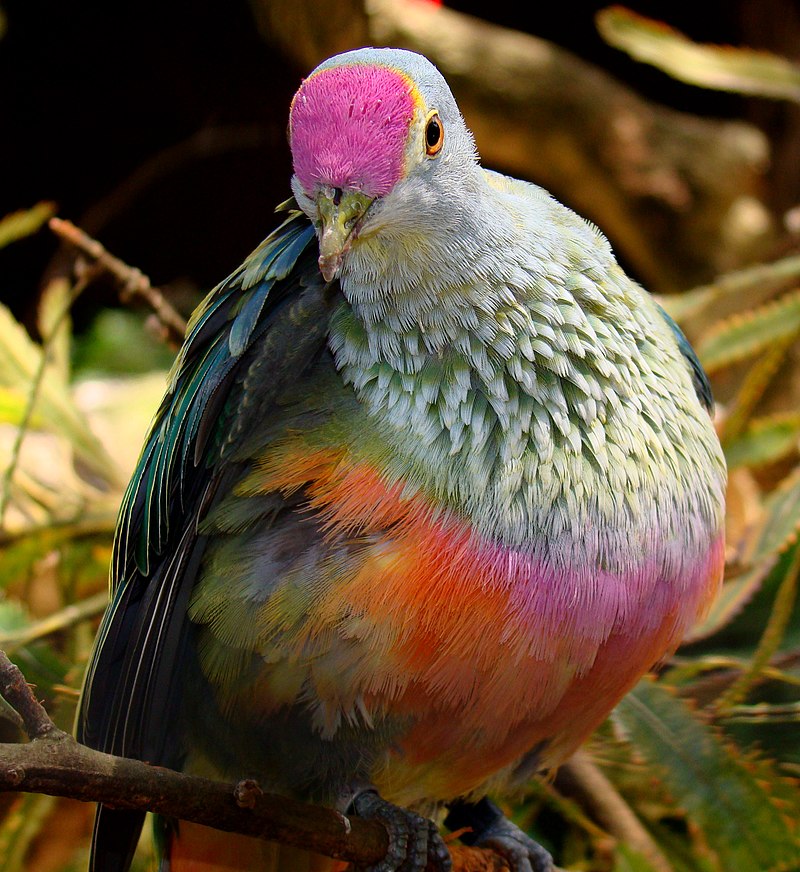
The Rose-crowned Fruit Dove is a beautiful and vibrant bird found mainly in the forests of Australia, New Guinea and some parts of Indonesia.
It has an unmistakable appearance due to its grey head and breast, orange belly, whitish throat and yellow-orange iris.
The crown on its head is pinkish-red with a yellow border which sets it apart from other fruit doves. This species can grow up to 22 cm long and have greyish green bills as well as feet.
In Indonesian subspecies however have white crowns instead of red ones.
They are generally found in small groups feeding on fruits or berries near trees or shrubs but they may also be seen alone occasionally when searching for food during the day time.
Scientific classification:
| Kingdom | Animalia |
| Phylum | Chordata |
| Class | Aves |
| Order | Columbiformes |
| Family | Columbidae |
| Genus | Ptilinopus |
| Species | P. regina |
7. Forest Kingfisher
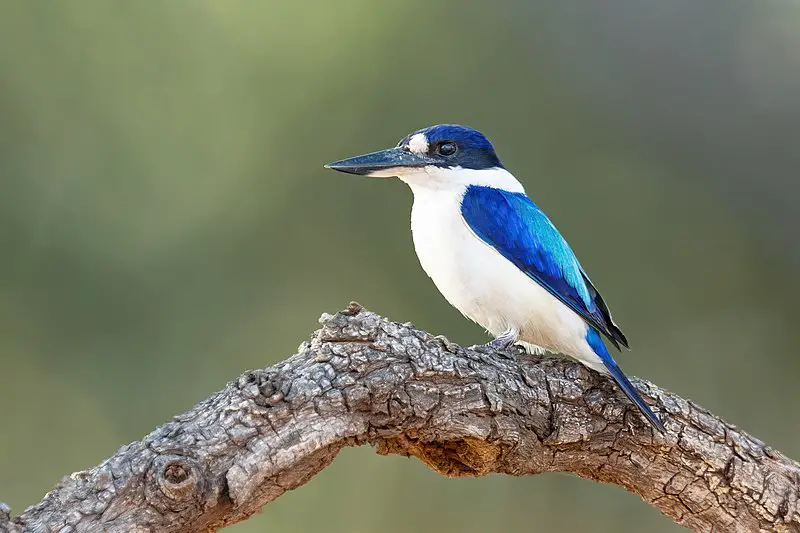
The Forest Kingfisher is an exquisite bird, boasting a vibrant blue and white plumage. It can be found in Indonesia, New Guinea, parts of Australia and other coastal areas.
This kingfisher prefers to hunt for invertebrates as well as small frogs or lizards, making it one of the most diverse hunters among its species.
Its diet helps to keep insect populations under control while also providing sustenance for this beautiful creature.
With its striking colors and impressive hunting skills, the Forest Kingfisher stands out amongst other birds living in similar habitats.
Scientific classification:
| Kingdom | Animalia |
| Phylum | Chordata |
| Class | Aves |
| Order | Coraciiformes |
| Family | Alcedinidae |
| Subfamily | Halcyoninae |
| Genus | Todiramphus |
| Species | T. macleayii |
Also Featured In: Papua New Guinea birds,
8. Varied Triller
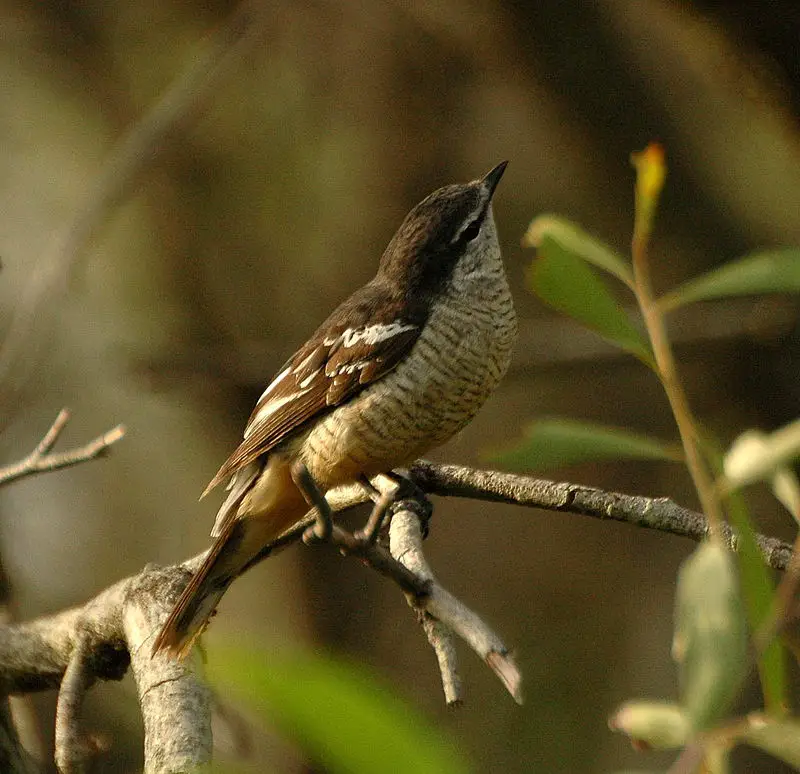
The varied triller is a small, colorful bird belonging to the cuckoo-shrike family. Native to New Guinea and the Bismarck Archipelago as well as parts of eastern Australia, this species prefers warm, fairly moist climates.
It has an unmistakable plumage that includes white wings with black barring and bright yellow underparts.
The head is grayish-brown while its tail feathers are largely brown but tipped in white.
Its call consists of a series of short whistles which it uses both for communication among flock members and territorial defense against other birds or predators in the area.
Although not widely known compared to some other avian species, these delightful birds can be seen flitting about their natural habitats if one knows where to look.
Scientific classification:
| Kingdom | Animalia |
| Phylum | Chordata |
| Class | Aves |
| Order | Passeriformes |
| Family | Campephagidae |
| Genus | Lalage |
| Species | L. leucomela |
9. Greater Sand Plover
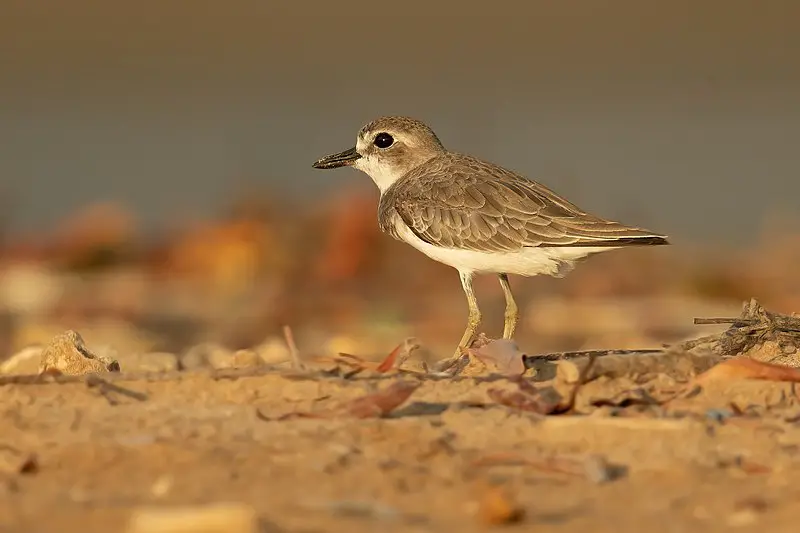
The Greater Sand Plover is a small wader, belonging to the plover family of birds. It’s scientific name Charadrius leschenaultii comes from the Latin word for a yellowish bird mentioned in the 4th century Vulgate.
These birds are typically found along coasts and sandy beaches where they feed on insects, mollusks and crustaceans.
They have grey-brown upperparts with white underparts and characteristic black bands across their chest as well as a prominent white forehead patch.
The Greater Sand Plovers breed mainly in India, Southeast Asia, Northern Australia and New Guinea while migrating to wintering grounds at coasts around South East Asia during nonbreeding season.
This species relies heavily on coastal wetlands so it is essential that these habitats be preserved in order for this species to survive into future generations.
Scientific classification:
| Kingdom | Animalia |
| Phylum | Chordata |
| Class | Aves |
| Order | Charadriiformes |
| Family | Charadriidae |
| Genus | Charadrius |
| Species | C. leschenaultii |
Also Featured In: Qatar birds, Birds of Goa
10. Red-Capped Plover
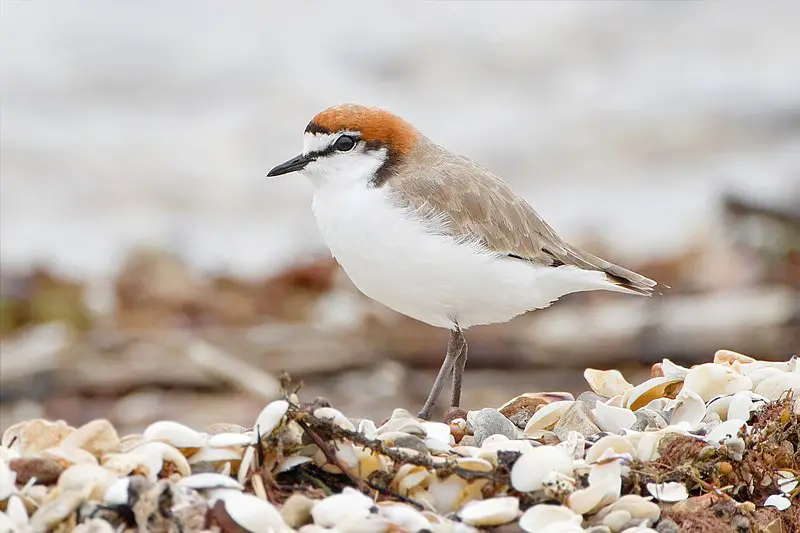
The Red-capped Plover, also known as the Red-capped Dotterel, is a small species of plover that breeds in Australia. It has a white forehead and underparts with grey-brown upperparts.
Adult males have a rust red crown on their heads while females lack this feature but still have some brown coloration across the nape of their necks.
The wings are blackish with bright yellow margins while they possess faint streaks underneath them.
Their long legs are grey or greenish in color and they usually run rather than fly when flushed from cover.
They feed mainly on insects which they hunt by wading through shallow water or probing soft mudflats for food items like worms and crustaceans.
Scientific classification:
| Kingdom | Animalia |
| Phylum | Chordata |
| Class | Aves |
| Order | Charadriiformes |
| Family | Charadriidae |
| Genus | Charadrius |
| Species | C. ruficapillus |
Also Featured In: Timor-Leste birds,
11. Dusky Moorhen
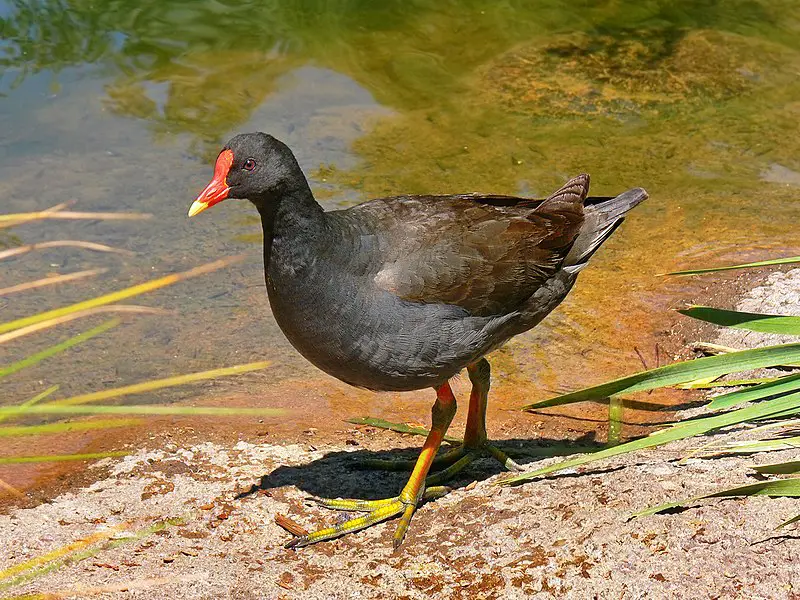
The dusky moorhen is a species of bird found in India, Australia, New Guinea, Borneo and Indonesia. It has dark plumage with an iridescent green sheen on its back and wings.
Its beak and legs are yellow-orange in color. The tail is long and pointed. Dusky moorhens live around freshwater wetlands such as swamps or ponds where they feed largely on aquatic vegetation but may also eat small insects or fish if available.
They often live alongside other birds from the same genus like purple swamphens or Eurasian coots which have similar appearances but different habitats preferences than their own species’.
Although timid when approached by humans these birds still make fascinating subjects for observation due to their unique behaviors within family groups that can help us understand more about them.
Scientific classification:
| Kingdom | Animalia |
| Phylum | Chordata |
| Class | Aves |
| Order | Gruiformes |
| Family | Rallidae |
| Genus | Gallinula |
| Species | G. tenebrosa |
12. White-Breasted Woodswallow
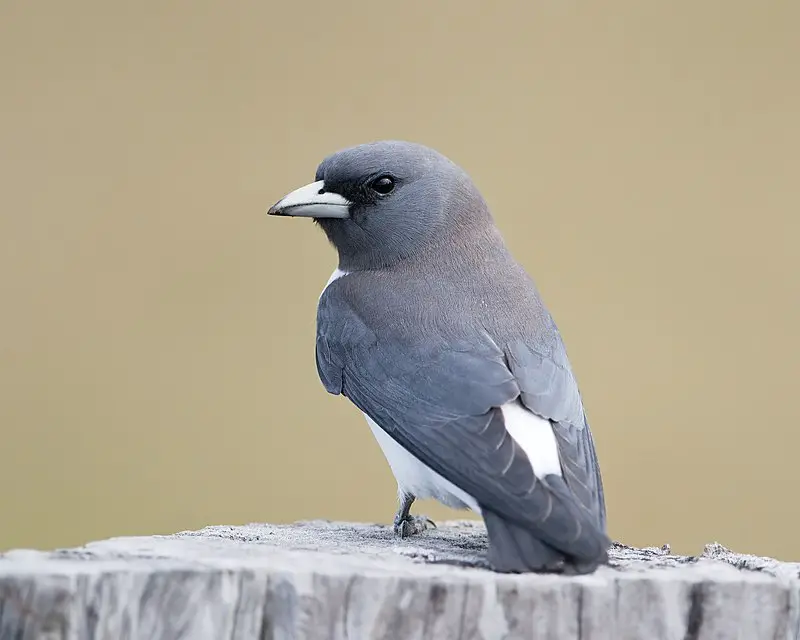
The White-breasted Woodswallow is a medium-sized passerine bird found in the Andaman Islands, Indonesia and Northern Australia.
Its name may be misleading as it does not belong to the family of true swallows but rather belongs to Artamidae which also includes butcherbirds, currawongs and Australian magpie.
These birds are mainly greyish brown with white belly patch and long wings having two pale bars on them.
They feed on insects like ants, beetles etc., captured from foliage or air during flight.
Breeding season for this species starts from October till December when they build their cup shaped nests out of twigs near tree trunks or branches usually high up in trees for protection against predators such as snakes or raptors.
Male woodswallows can often been seen singing loudly while displaying its aerial maneuvering capabilities trying to attract potential mates.
Scientific classification:
| Kingdom | Animalia |
| Phylum | Chordata |
| Class | Aves |
| Order | Passeriformes |
| Family | Artamidae |
| Genus | Artamus |
| Species | A. leucorynchus |
Also Featured In: Brunei birds, Birds that Live Near Halmahera
13. Brown Goshawk
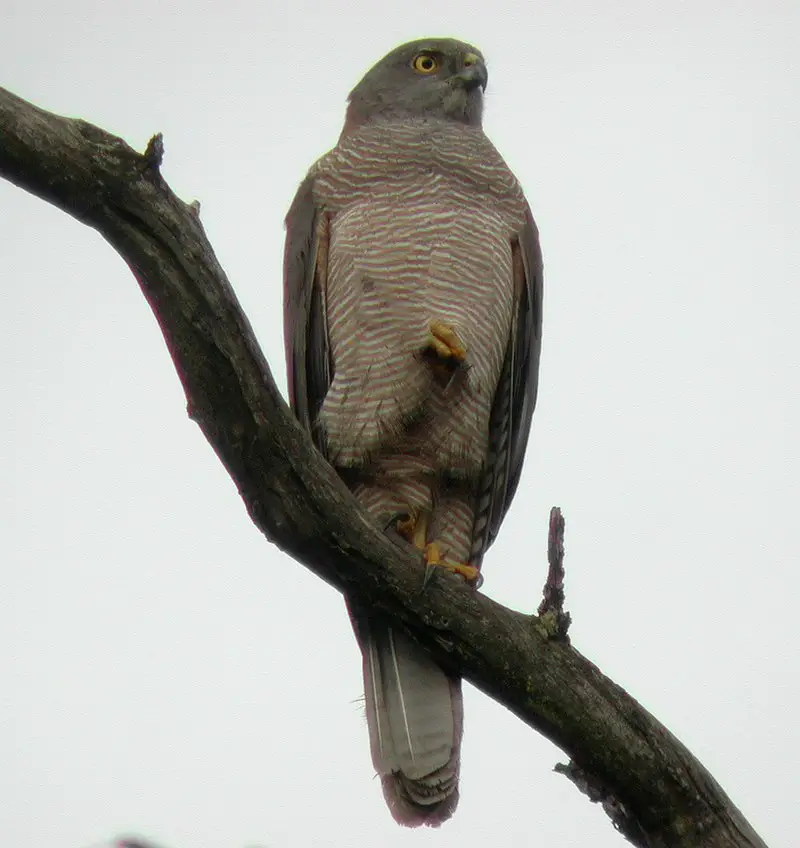
The Brown Goshawk is a medium-sized bird of prey that can be found in Australia and its surrounding islands.
It has grey upperparts with chestnut collar, while the underparts are mainly rufous finely barred with white.
This gives it similar colouring to collared sparrowhawk but it is larger as compared to them; body length being between 40-55 cm.
The flight of this majestic raptor is fast and flexible making for an impressive sight when spotted in the sky.
Its diet consists mostly of small birds, mammals such as rodents or bats, large insects like grasshoppers etc., thus playing an important role in maintaining balance within local ecosystems by controlling population numbers these species.
Scientific classification:
| Kingdom | Animalia |
| Phylum | Chordata |
| Class | Aves |
| Order | Accipitriformes |
| Family | Accipitridae |
| Genus | Accipiter |
| Species | A. fasciatus |
Also Featured In: Vanuatu birds,
14. Grey-Tailed Tattler
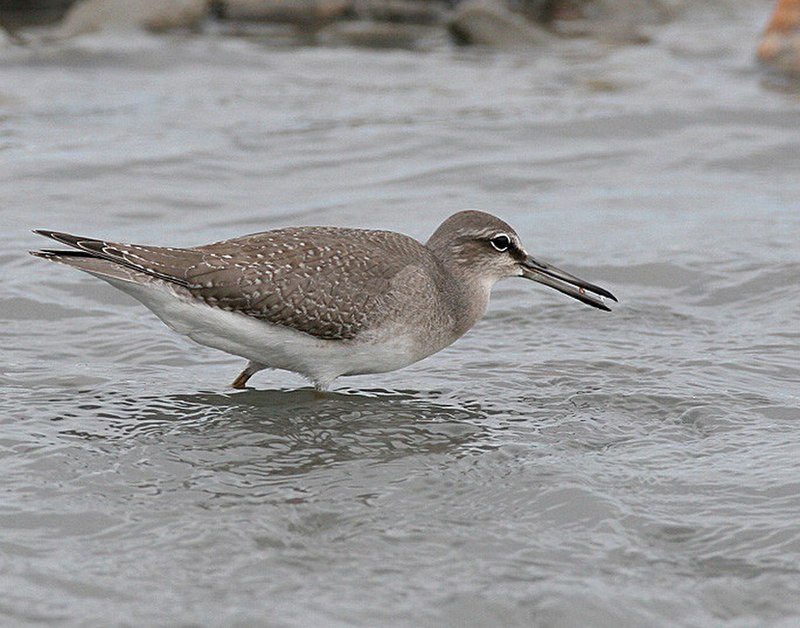
The Grey-tailed Tattler is a small shorebird belonging to the genus Tringa. It has an unmistakable noisy call, which gives it its name.
These birds are found in coastal areas of Siberia and Polynesia, as well as some other places around Asia and Australia.
They have mottled grey plumage with darker wings, white bellies and long yellow legs; they also have distinctive black stripes on their necks that run down onto their chests.
The Grey-tailed Tattler feeds mainly on aquatic insects or worms at low tide but will sometimes take seeds from plants when available too.
During breeding season these birds nest near water bodies such as rivers or creeks in shallow depressions lined with leaves made by both parents who then share incubation duties for about three weeks until the eggs hatch after which time both males and females help raise young chicks before they fledge within about 30 days of hatching.
Scientific classification:
| Kingdom | Animalia |
| Phylum | Chordata |
| Class | Aves |
| Order | Charadriiformes |
| Family | Scolopacidae |
| Genus | Tringa |
| Species | T. brevipes |
Also Featured In: Cook Islands birds, Common Republic of Nauru Birds
15. Grey Falcon
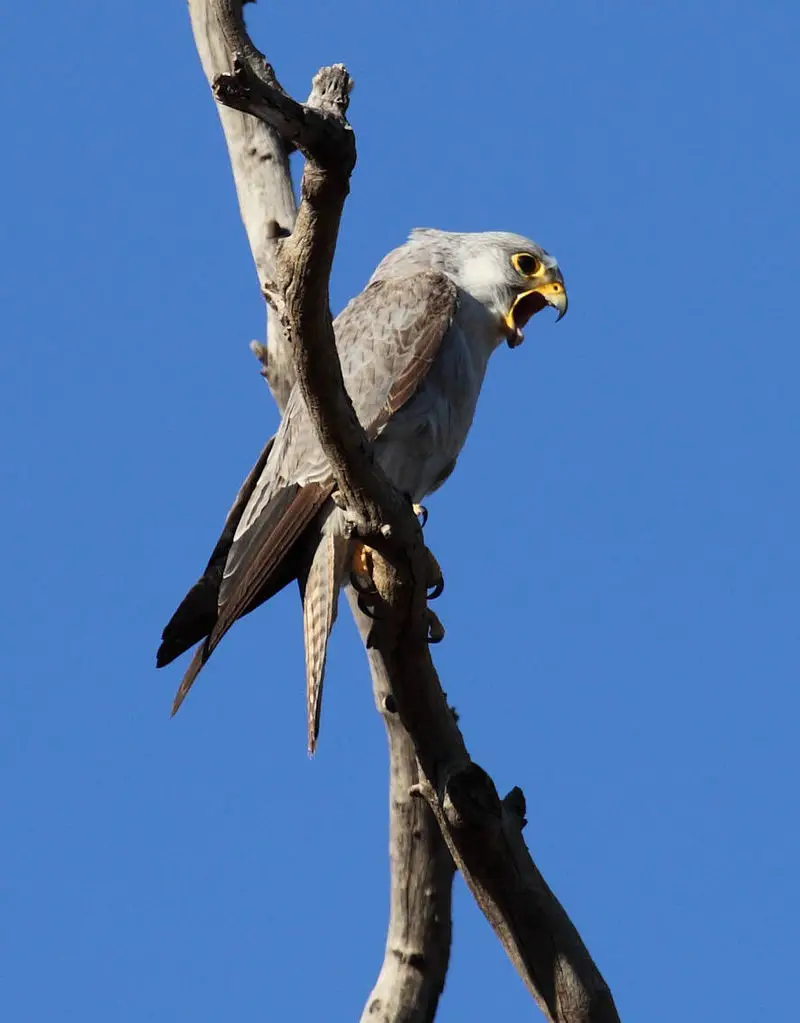
The Grey Falcon is a medium-sized species of Falco native to Australia, and one of its rarest raptors. It has been classified as Vulnerable due to its scarcity throughout the country.
First described by John Gould in 1841, based on a specimen found in York, Western Australia provided by pastoralist Lockier Burges.
The grey falcon usually inhabits open habitats such as semi-arid plains or grasslands with scattered trees, where it nests on tall shrubs or rock ledges near water sources while hunting for small birds and mammals from above using impressive aerial acrobatics and speed dives.
Conservation efforts are underway to ensure the survival of this beautiful bird which plays an important role within their ecosystem.
Scientific classification:
| Kingdom | Animalia |
| Phylum | Chordata |
| Class | Aves |
| Order | Falconiformes |
| Family | Falconidae |
| Genus | Falco |
| Species | F. hypoleucos |
Also Featured In: Falcons Species,
16. Nankeen Night Heron
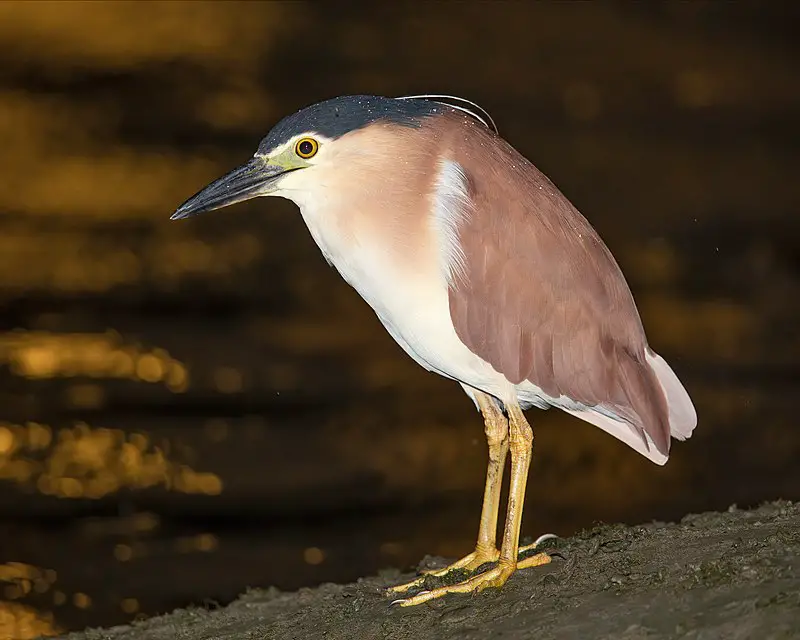
The Nankeen night heron is a beautiful bird with its distinct reddish-brown colour. It can be found in an impressive range of habitats, including forests, meadows, shores and swamps.
Primarily nocturnal by nature, these birds are most active during the dark hours of the day.
Measuring between 55 to 65 cm long they have broad wings which help them soar through the air gracefully at great speeds when hunting for food or migrating across continents.
Their diet primarily consists of small fish and other aquatic creatures that live in lakes or rivers near their homes.
For many people living near water sources like ponds or streams this species has become a familiar sight as it often comes out to feed on insects at dusk.
Scientific classification:
| Kingdom | Animalia |
| Phylum | Chordata |
| Class | Aves |
| Order | Pelecaniformes |
| Family | Ardeidae |
| Genus | Nycticorax |
| Species | N. caledonicus |
Also Featured In: Herons Species, Birds that Live around Victoria
17. White-Necked Heron
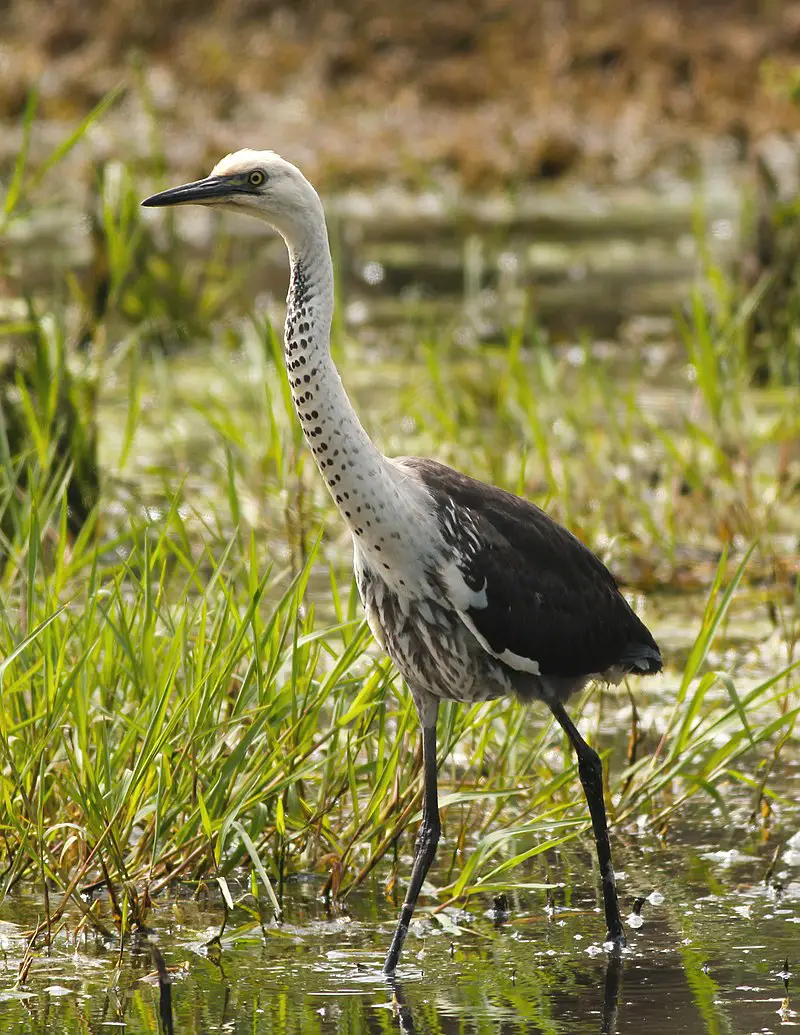
The white-necked heron, or Pacific heron, is a species of large water bird found across much of Australia. It has also been spotted in Indonesia, New Guinea and New Zealand but is rarer in Tasmania.
These birds are nomadic by nature and move from one water source to the next depending on availability.
They have long legs which enable them to wade through shallow waters looking for prey such as fish, crustaceans and insects.
Their feathers are greyish with a distinctive white neck patch that gives these birds their name – they can be seen standing tall at the edge of rivers or lakes watching for movement underwater before diving down gracefully into the depths.
Scientific classification:
| Kingdom | Animalia |
| Phylum | Chordata |
| Class | Aves |
| Order | Pelecaniformes |
| Family | Ardeidae |
| Genus | Ardea |
| Species | A. pacifica |
Also Featured In: Birds that Live around Brisbane, Common Townsville Birds
18. Great-Billed Heron
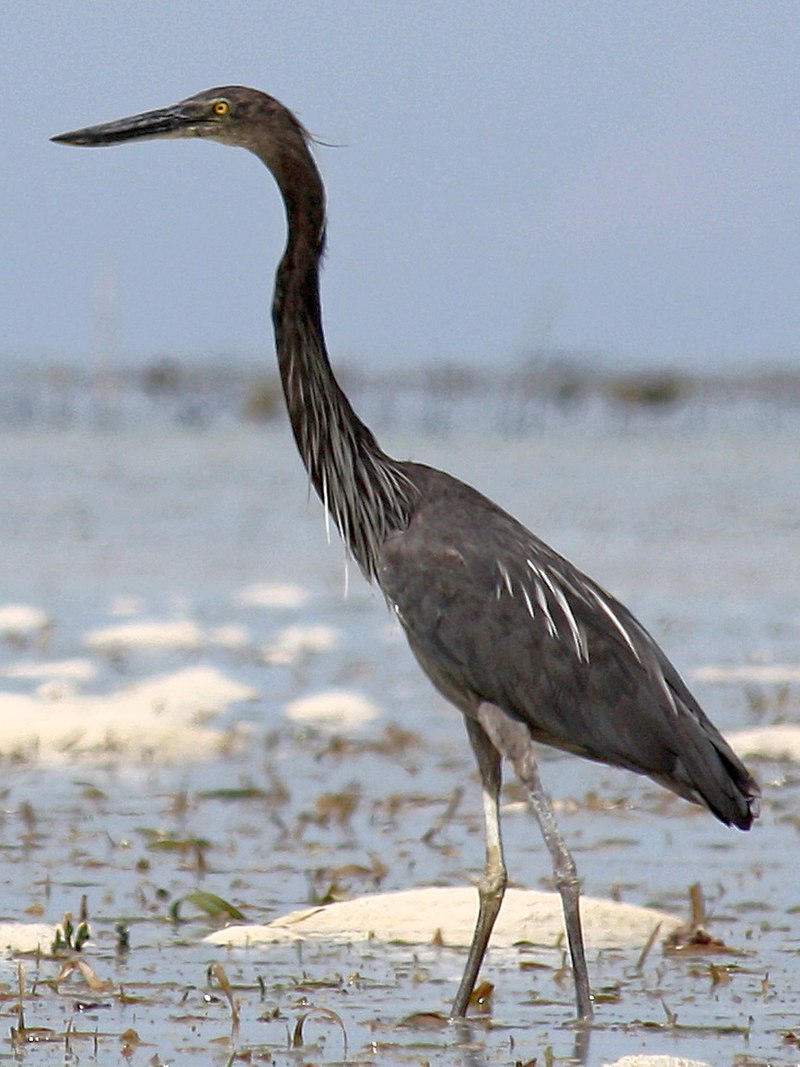
The Great-billed Heron is a majestic bird of the heron family found in Southeast Asia, Papua New Guinea and Australia.
Standing at an impressive 115cm tall and weighing up to 2.6kg, this magnificent creature is larger than the Purple Heron with which it shares many similarities including its dark grey plumage above and white feathers below its wings.
Its distinguishing feature however are its huge yellow bill as well as large black legs ending in webbed feet that allow for easy movement through shallow water while hunting prey such as fish or frogs.
A formidable hunter during daylight hours but also known to be quite vocal at night time too.
Scientific classification:
| Kingdom | Animalia |
| Phylum | Chordata |
| Class | Aves |
| Order | Pelecaniformes |
| Family | Ardeidae |
| Genus | Ardea |
| Species | A. sumatrana |
Also Featured In: Birds That Live In Phuket Island,
19. Black Bittern
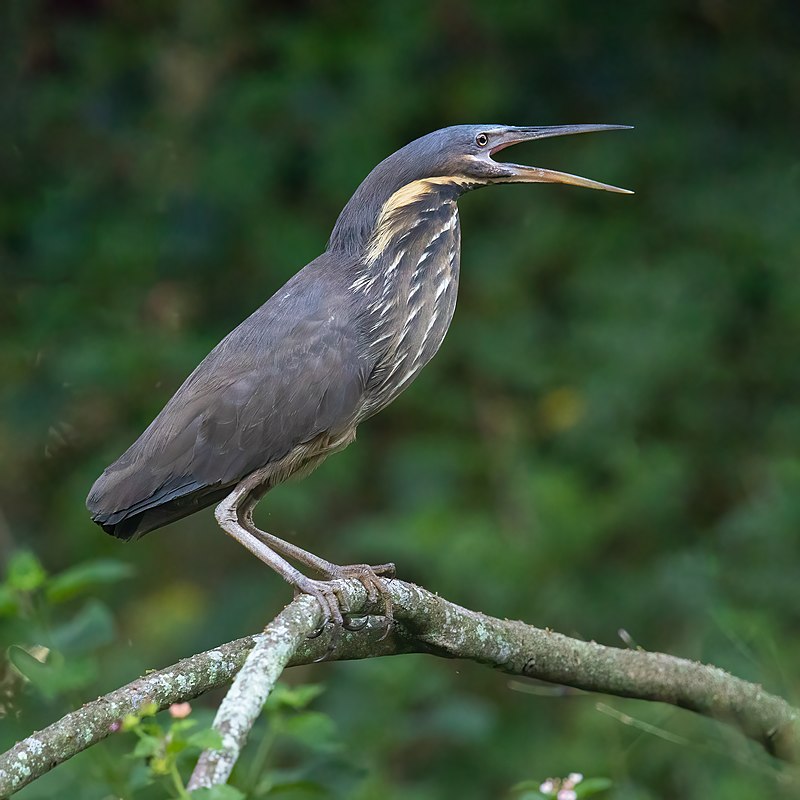
The Black Bittern is a large species of bird found in tropical Asia, stretching from Pakistan to China and Indonesia. It measures 58 cm (23 inches) long which makes it the largest bittern within its genus Ixobrychus.
The bird has black feathers on its back with white stripes running down either side, dark brown upper parts and yellow-brown underparts.
Its bill is short and thick while legs are greenish-yellow in color. They mainly reside where they breed but some northern birds migrate for shorter distances during winter seasons.
These birds feed upon fish, frogs, insects as well as small reptiles among other things making them omnivorous predators of their environment.
Scientific classification:
| Kingdom | Animalia |
| Phylum | Chordata |
| Class | Aves |
| Order | Pelecaniformes |
| Family | Ardeidae |
| Genus | Ixobrychus |
| Species | I. flavicollis |
Also Featured In: Common Birds that Live in Odisha, Birds of Karnataka
20. Little Kingfisher
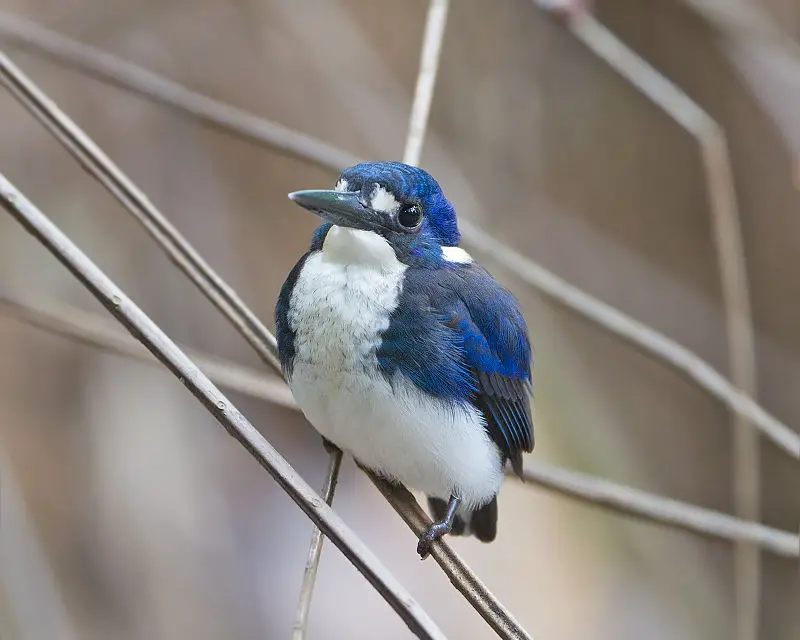
The Little Kingfisher is a small and vibrant species of kingfishers found in the subfamily Alcedininae.
It has an exquisite coloration, with its upperparts being mainly blue or greenish-blue while its head and underparts are bright orange to red.
Its bill is long, thin, and black. This beautiful bird inhabits tropical moist lowland forests near bodies of water such as rivers and streams where they can hunt for fish at night using their sharp vision. They also feed on aquatic insects like dragonflies during the day.
The name Ceyx derives from Greek mythology – which refers to a seabird that was drowned by Zeus himself. A fascinating animal indeed.
Scientific classification:
| Kingdom | Animalia |
| Phylum | Chordata |
| Class | Aves |
| Order | Coraciiformes |
| Family | Alcedinidae |
| Subfamily | Alcedininae |
| Genus | Ceyx |
| Species | C. pusillus |
Also Featured In: Kingfishers Species, Birds that Found in Kakadu National Park
21. Blue-Winged Kookaburra
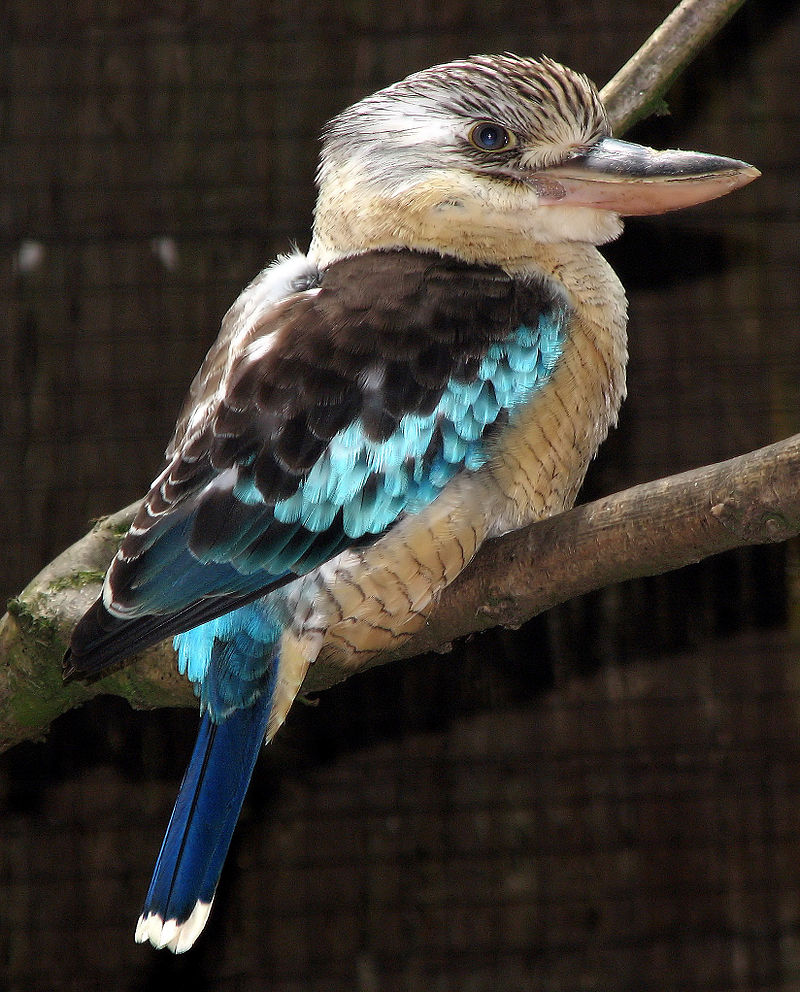
The Blue-winged Kookaburra (Dacelo leachii) is a stunning bird native to northern Australia and southern New Guinea.
It measures around 40 cm, making it slightly smaller than its more well known relative, the laughing kookaburra.
Its plumage varies between cream colouring with brownish bars on its upper and underparts, as well as blue wings and brown shoulders. Additionally, males have a striking blue tail while females lack this feature.
This species of kingfisher feeds mainly on small reptiles such as lizards or snakes but occasionally they will take rodents or even insects.
They can be found in open woodlands near rivers or creeks during the day time where their call – which sounds like laughter – is quite distinct from other birds in the area.
Scientific classification:
| Kingdom | Animalia |
| Phylum | Chordata |
| Class | Aves |
| Order | Coraciiformes |
| Family | Alcedinidae |
| Subfamily | Halcyoninae |
| Genus | Dacelo |
| Species | D. leachii |
Also Featured In: Most Common Western Australia Birds,
22. Australian Pied Cormorant
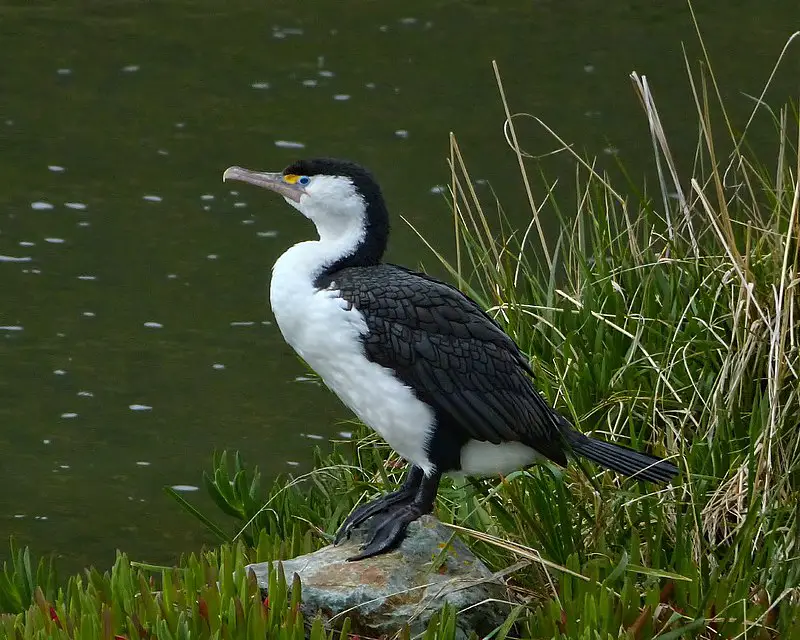
The Australian pied cormorant is a medium-sized member of the cormorant family and can be found around the coasts of Australasia.
It’s distinctive plumage features black feathers on its head, back, wings and tail with some white patches in between.
Its face has yellow skin that becomes bright orange when breeding season begins. The bird uses it’s webbed feet to swim through water searching for food such as fish or small crustaceans which make up most of their diet.
They often hunt by diving underwater from where they can stay submerged for about 30 seconds before resurfacing again for air.
During these dives they are able to travel depths up to 15 meters down.
This species also forms colonies when mating season comes around and will nest together in tall trees near shorelines or other bodies of water so that fishing is easier within reach during this time period every year.
Scientific classification:
| Kingdom | Animalia |
| Phylum | Chordata |
| Class | Aves |
| Order | Suliformes |
| Family | Phalacrocoracidae |
| Genus | Phalacrocorax |
| Species | P. varius |
Also Featured In: Cormorant Species, Common Melbourne Birds
23. Little Black Cormorant
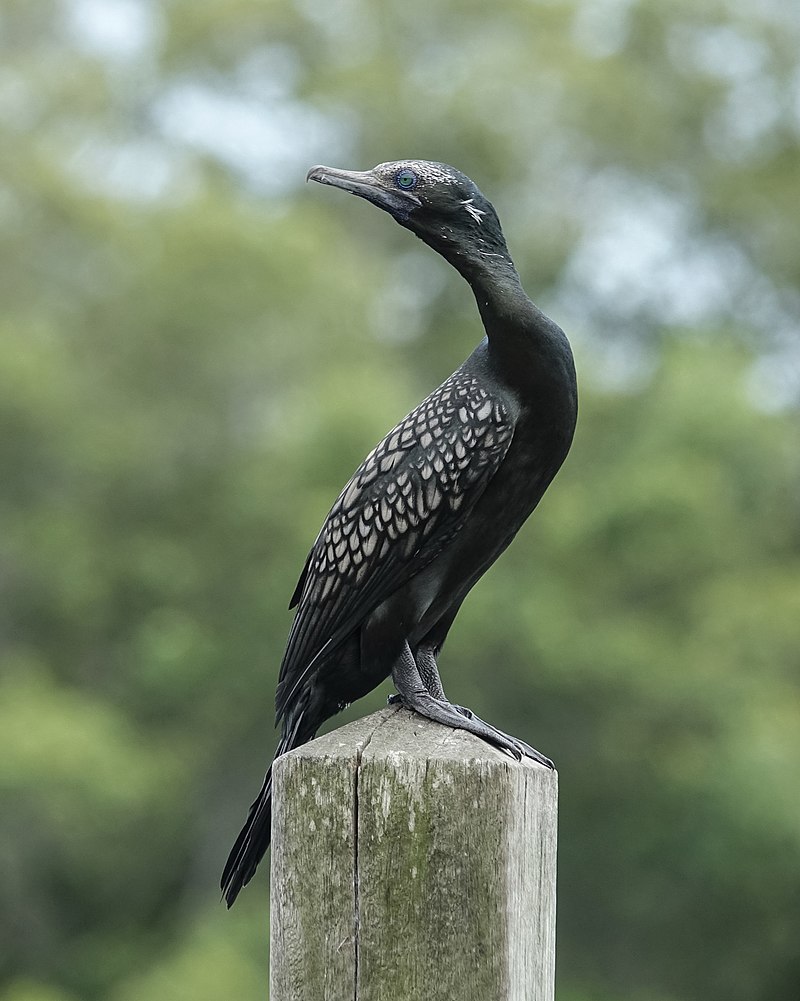
The little black cormorant is a small seabird of the cormorant family that is commonly found in rivers, lakes and coastal areas throughout Australia and New Zealand.
It has an all-black colouring with blue-green eyes and grows to about sixty centimetres long. This species was formally described by German ornithologist Johann Jakob Kaup in 1837 as Phalacrocorax sulcirostris.
The little black cormorant feeds on insects, fish and crustaceans which it captures underwater, diving up to two metres deep for around twenty seconds at a time.
They are known for their large breeding colonies where they build nests out of twigs or seaweed near water bodies like sandbanks or rocky cliffsides.
Little black cormorants can also be seen perching atop rocks drying off after swimming or preening themselves while perched low over the water’s surface.
Scientific classification:
| Kingdom | Animalia |
| Phylum | Chordata |
| Class | Aves |
| Order | Suliformes |
| Family | Phalacrocoracidae |
| Genus | Phalacrocorax |
| Species | P. sulcirostris |
Also Featured In: South Australian Birds, Sydney Birds You Need to See
24. Australasian Darter
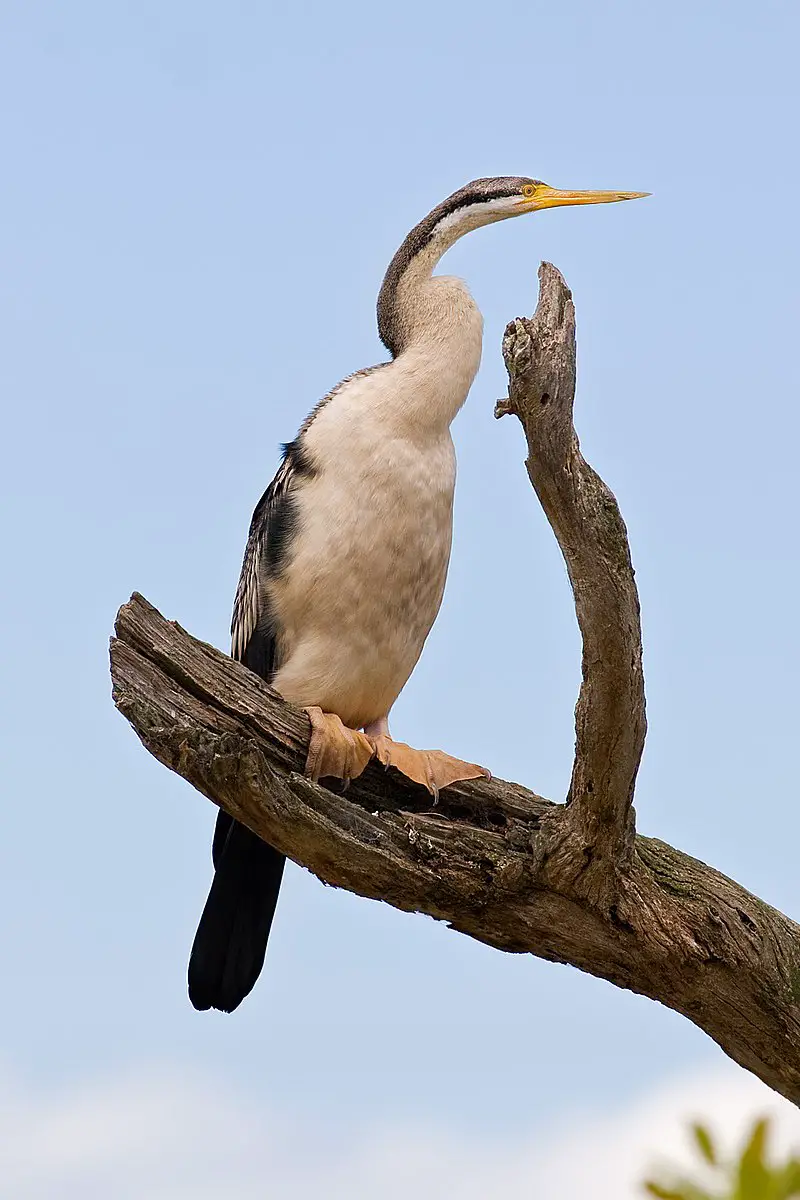
The Australasian Darter, also known as the Australian Darter, is a species of bird in the darter family. It can be found across Australia, Indonesia and Papua New Guinea.
This large bird has an impressive wingspan between 86-94 cm and weighs up to 2.6 kgs.
First discovered by John Gould in 1847, this long necked creature loves to swim and hunt for food underwater before drying its feathers on tree branches or rocks afterwards – like other Anhingidae species do.
They mainly feed on fish but will eat crustaceans too if they are around. With beautiful black plumage with white markings on their wings and tail these birds stand out from most others due to their unique style when it comes to fishing.
Scientific classification:
| Kingdom | Animalia |
| Phylum | Chordata |
| Class | Aves |
| Order | Suliformes |
| Family | Anhingidae |
| Genus | Anhinga |
| Species | A. novaehollandiae |
Also Featured In: Queensland Birds You Should Know, Birds that You’ll find in Perth
25. Grey Teal
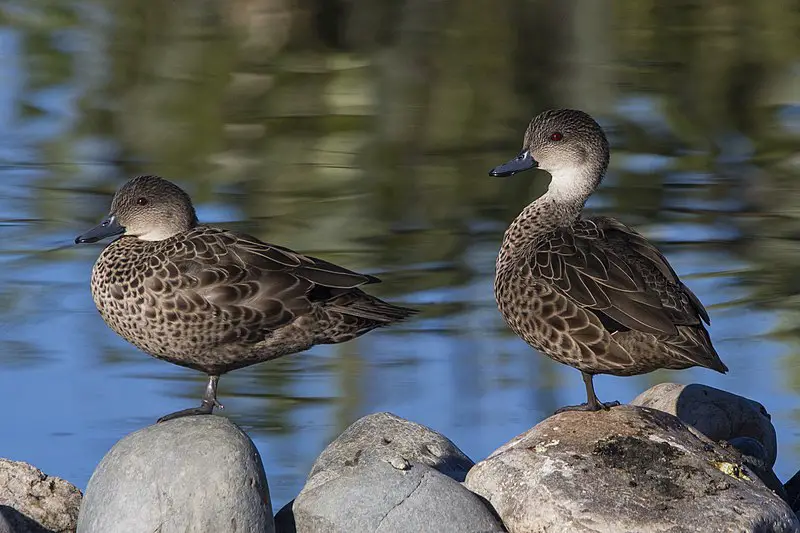
The Grey Teal is a beautiful dabbling duck native to Australia and New Zealand. It can be identified by its mottled brown feathers, white and green flashes on the wings and most noticeably, an adult male’s crimson coloured iris in its eyes.
Males and females share the same colouration unlike other ducks of similar species which have different feather patterns between sexes.
The Grey Teal prefers open wetlands for habitat where it feeds mainly on aquatic plants but also small crustaceans or insects as part of their diet.
They are usually found in family groups with one female accompanied by several males during breeding season when courtship begins until nesting occurs around May-June time frame each year depending upon location.
Scientific classification:
| Kingdom | Animalia |
| Phylum | Chordata |
| Class | Aves |
| Order | Anseriformes |
| Family | Anatidae |
| Genus | Anas |
| Species | A. gracilis |
Also Featured In: birds of teal,
26. Australasian Grebe
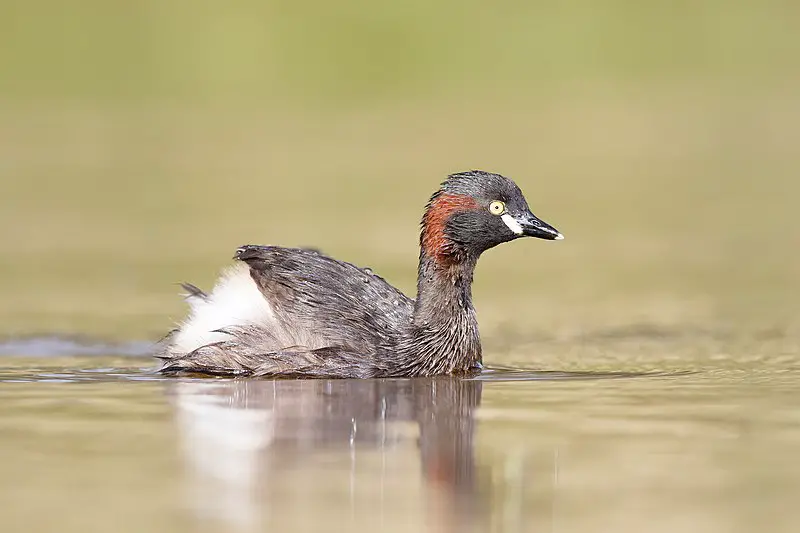
The Australasian grebe is a small waterbird that is frequently seen on fresh water lakes and rivers in Australia, New Zealand, and the Pacific islands. It is one of the smallest members of the grebe family, measuring only 25-27 cm in length.
The bird has a dark brown upper body and a glossy-black head and neck, making it quite striking in appearance.
Both male and female Australasian grebes look alike, and the species is known for its strong swimming and diving abilities.
Due to its reliance on freshwater ecosystems, the Australasian grebe is highly vulnerable to habitat loss and other environmental threats.
Conservation efforts are underway to protect this unique and important bird species.
Scientific classification:
| Kingdom | Animalia |
| Phylum | Chordata |
| Class | Aves |
| Order | Podicipediformes |
| Family | Podicipedidae |
| Genus | Tachybaptus |
| Species | T. novaehollandiae |
Also Featured In: Birds of Tasmania, New South Wales Birds You Need to See
27. Black-Faced Cuckooshrike
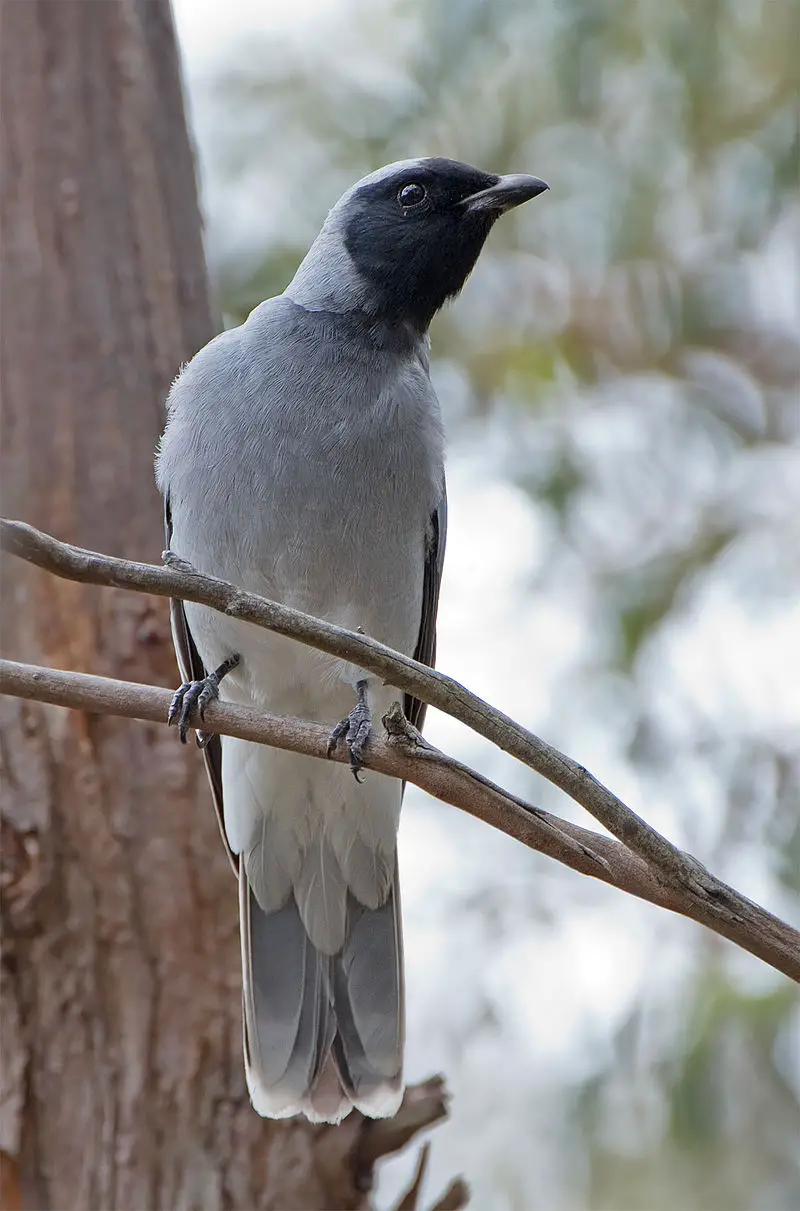
The Black-faced cuckooshrike, found in Australia and southern New Guinea, is a protected species under Australian law.
These birds are omnivorous and commonly seen in wooded habitats, with the exception of rainforests.
Despite this, they are also sometimes found in urban areas. The Black-faced cuckooshrike is a passerine bird and is known for its distinctive black facial markings.
Scientific classification:
| Kingdom | Animalia |
| Phylum | Chordata |
| Class | Aves |
| Order | Passeriformes |
| Family | Campephagidae |
| Genus | Coracina |
| Species | C. novaehollandiae |
Also Featured In: Common Flinders Island Birds,
28. Olive-Backed Oriole
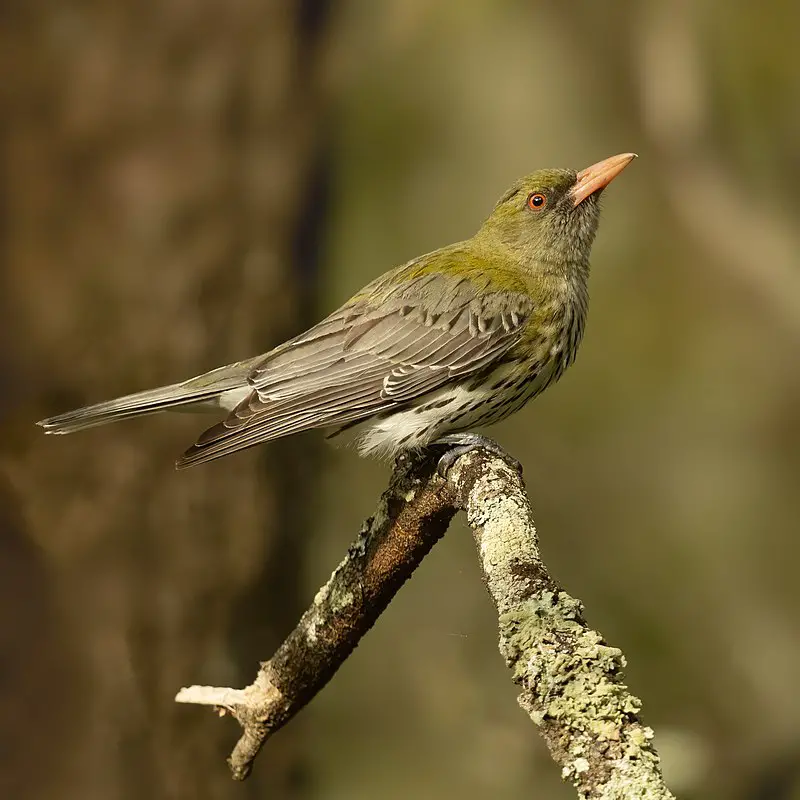
The olive-backed oriole is a medium-sized bird found in northern and eastern Australia and south-central New Guinea. It is known for its noisy and conspicuous behavior, making it easy to spot.
This bird was first described by John Latham in 1801, and is the most widespread Australasian oriole. With its distinctive white belly, this bird is a common sight among trees and bushes.
The olive-backed oriole belongs to the Coracias genus and has four sub-species.
It is a passerine bird that is often vocal, producing a range of calls and songs. If you’re ever in northern or eastern Australia or south-central New Guinea, keep an eye out for the olive-backed oriole and its beautiful plumage.
Scientific classification:
| Kingdom | Animalia |
| Phylum | Chordata |
| Class | Aves |
| Order | Passeriformes |
| Family | Oriolidae |
| Genus | Oriolus |
| Species | O. sagittatus |
Also Featured In: Birds that Charles Darwin Studied, Birds that Live in Sunshine Coast
29. Hardhead
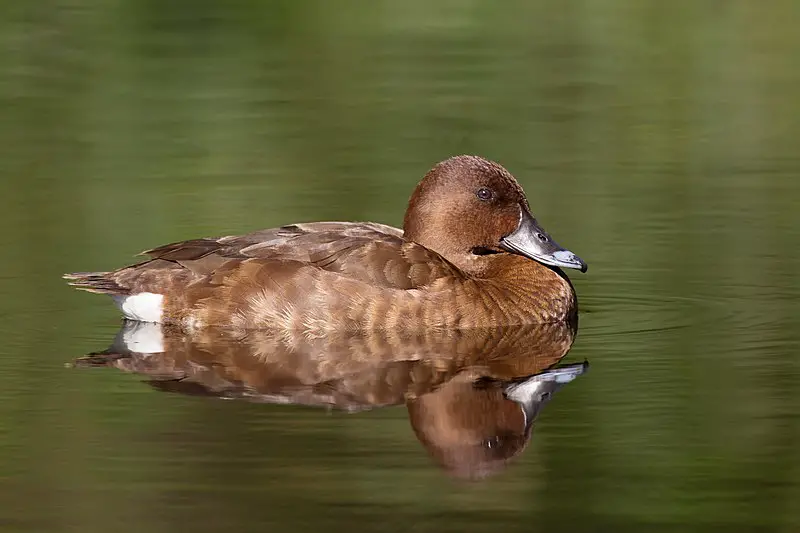
The Hardhead bird, scientifically known as Aythya australis, is the only genuine diving duck found in Australia. Its common name, “hardhead,” refers to the taxidermists’ difficulty processing its head, not its skull’s density.
These birds are typically found in wet coastal regions of Australia, mainly in the southeast. They have white eyes and are usually grey or black with a bluish-black bill.
As diving ducks, Hardheads dive deep into the water to forage for aquatic plants, mollusks, and invertebrates.
They are relatively quiet birds with a harsh, low quack sound. Hardheads play an important role in aquatic ecosystems as they help to control the growth of certain plants, keep waterways clean, and are preyed upon by larger birds and reptiles.
Scientific classification:
| Kingdom | Animalia |
| Phylum | Chordata |
| Class | Aves |
| Order | Anseriformes |
| Family | Anatidae |
| Genus | Aythya |
| Species | A. australis |
30. Mistletoebird
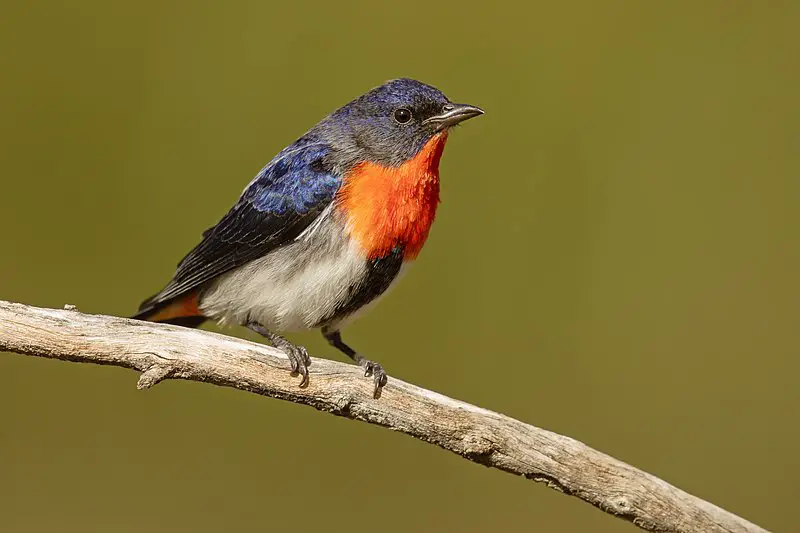
The mistletoebird is a small, colorful bird found in Australia and the eastern Maluku Islands. It feeds mainly on the berries of the parasitic mistletoe and plays a role in the plant’s reproduction by distributing its seeds.
This bird is also known as the mistletoe flowerpecker due to its habit of gathering soft materials to create its nest, which is shaped like a small purse.
The male mistletoebird has a bright red head and chest, while the female has olive-green plumage with a reddish patch on its throat.
Despite its size, this bird has a loud and melodious song. The mistletoebird’s distribution across much of Australia makes it a familiar sight to many Australians, particularly during the holiday season when mistletoe is used as a festive decoration.
Scientific classification:
| Kingdom | Animalia |
| Phylum | Chordata |
| Class | Aves |
| Order | Passeriformes |
| Family | Dicaeidae |
| Genus | Dicaeum |
| Species | D. hirundinaceum |
Also Featured In: Birds of Far North Queensland,
31. Scarlet Myzomela
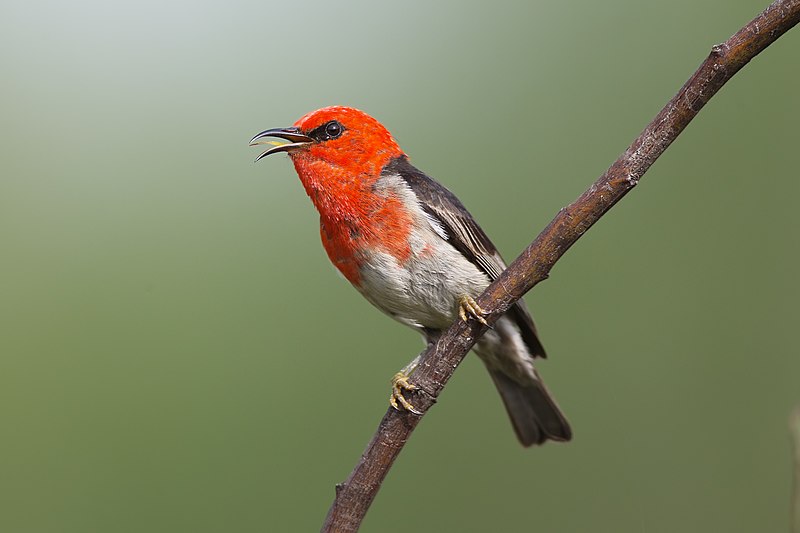
The Scarlet myzomela, also known as the Scarlet honeyeater, is a tiny bird from Australia belonging to the honeyeater family. It was identified by John Latham, an ornithologist from England in 1801.
With a length of only 9 to 11 centimeters, it is the smallest honeyeater bird in Australia featuring a short tail and a long, down-curved beak.
The male and female Scarlet myzomelas have a noticeable difference with respect to their gender.
The male Scarlet myzomela has a vibrant scarlet coloration while female birds have olive-green feathers. Scarlet myzomela birds often feed on the nectar of flowers while hovering in the air.
These birds are seen to feed on plants such as eucalyptus, grevillea, and paperbark among others.
Scarlet myzomelas are little creatures that add vibrancy to the colorful wildlife of Australia.
Scientific classification:
| Kingdom | Animalia |
| Phylum | Chordata |
| Class | Aves |
| Order | Passeriformes |
| Family | Meliphagidae |
| Genus | Myzomela |
| Species | M. sanguinolenta |
32. Bar-Shouldered Dove
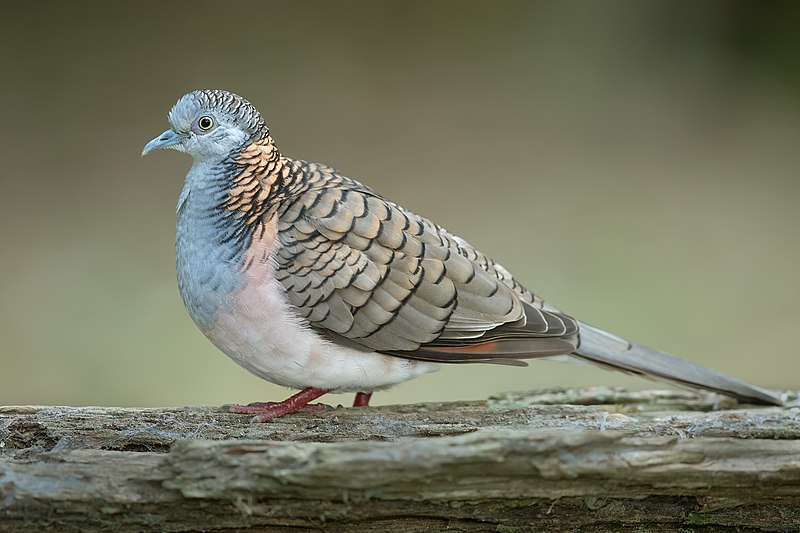
The Bar-shouldered dove, also known as Geopelia humeralis, is a medium-sized pigeon species that can be found in Australia and Southern New Guinea. This bird is protected by the National Parks and Wildlife Act of 1974.
It has a unique and pleasing voice that sounds like “cook-a-wook” or “coolicoo.” Additionally, the Bar-shouldered dove has blue-grey breast feathers and chequered brown-bronze wings. It is quite striking to look at and is known for its long, elegant tail.
This bird is a fascinating species with a lot of fun facts to explore.
Scientific classification:
| Kingdom | Animalia |
| Phylum | Chordata |
| Class | Aves |
| Order | Columbiformes |
| Family | Columbidae |
| Genus | Geopelia |
| Species | G. humeralis |
33. Magpie-Lark
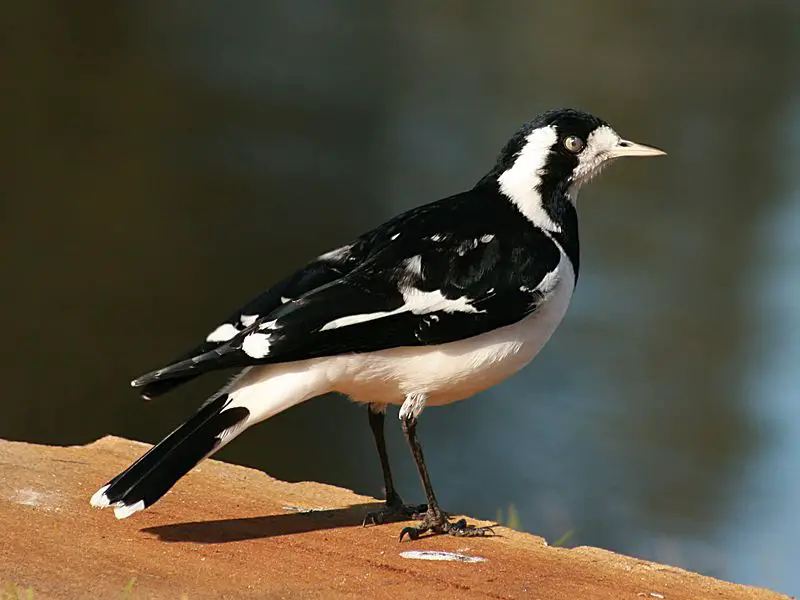
The Magpie-lark is a bird found in Australia, Timor, and southern New Guinea. It has black and white plumage, with different patterns for males and females.
John Latham first described this species in 1801. Formerly known as a mudnest builder, it has been reclassified recently.
The bird has several nicknames such as Wee magpie, Peewee, Peewit, and Mudlark.
It is a passerine bird, and its scientific name is Grallina cyanoleuca. The Magpie-lark is known for its beautiful call, which is similar to the sound “pee-wee.” It is a unique species that adds to the diversity of Australia’s wildlife.
The bird is a favourite among birdwatchers and nature lovers in general.
Scientific classification:
| Kingdom | Animalia |
| Phylum | Chordata |
| Class | Aves |
| Order | Passeriformes |
| Family | Monarchidae |
| Genus | Grallina |
| Species | G. cyanoleuca |
Also Featured In: Birds that Live Near Adelaide,
34. Helmeted Friarbird
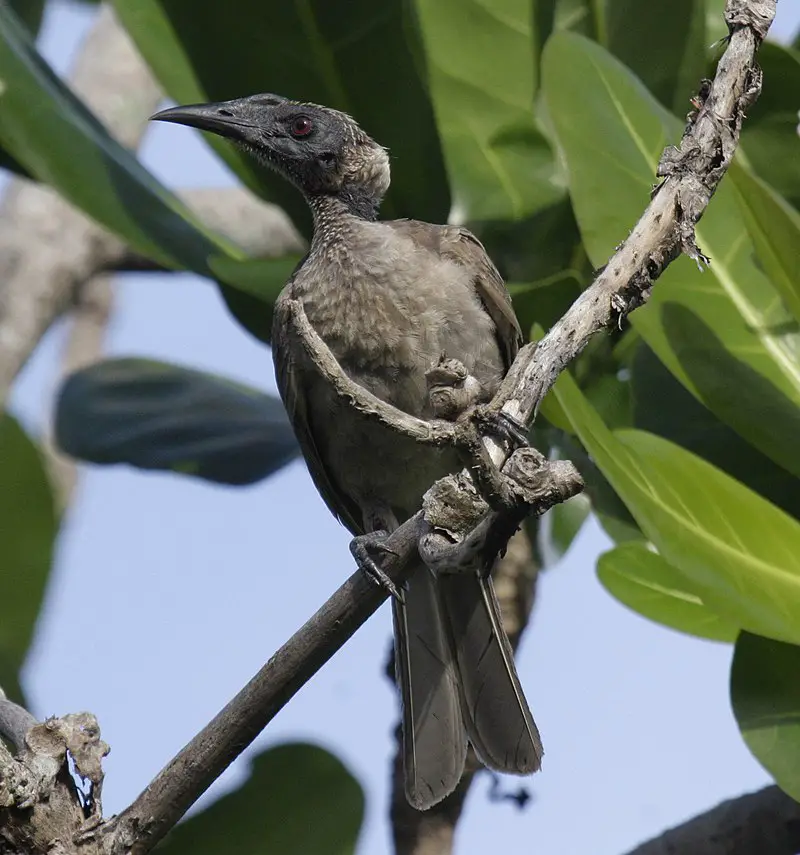
The helmeted friarbird, also known as the “leatherhead,” is a member of the Meliphagidae family of birds. It has a distinctive dark gray face with striking red eyes.
Its overall coloring is gray-brown, with a fading white color around the chest area, which becomes spotted as it gets closer to the feet.
The helmeted friarbird is widespread in Australia and Indonesia, and its subspecies have similar characteristics.
These birds are known for their distinctive appearance and are often spotted by birdwatchers in their natural habitats.
Overall, the helmeted friarbird is a fascinating and unique bird that is worth observing for bird enthusiasts and nature lovers alike.
Scientific classification:
| Kingdom | Animalia |
| Phylum | Chordata |
| Class | Aves |
| Order | Passeriformes |
| Family | Meliphagidae |
| Genus | Philemon |
| Species | P. buceroides |
35. Dusky Myzomela
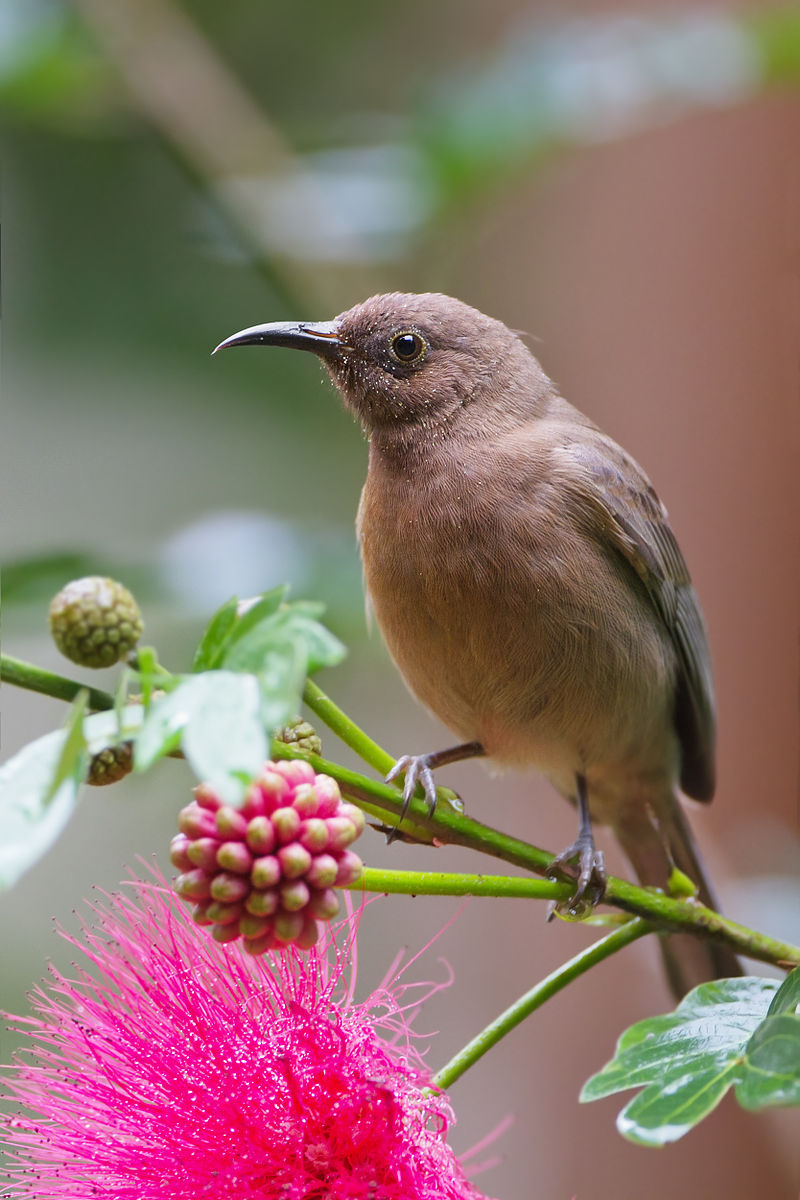
The dusky myzomela, also known as the dusky honeyeater, is a small bird found in the Aru Islands, southern New Guinea, and northern and eastern Australia.
It has two separate populations in Australia, one in the Top End and the other from Cape York Peninsula along the east coast. The bird is brown in color and a common resident of the areas it inhabits.
It is small in size and resembles a honeyeater. However, the dusky myzomela is a rare species south of Rockhampton.
Scientific classification:
| Kingdom | Animalia |
| Phylum | Chordata |
| Class | Aves |
| Order | Passeriformes |
| Family | Meliphagidae |
| Genus | Myzomela |
| Species | M. obscura |
36. Peaceful Dove
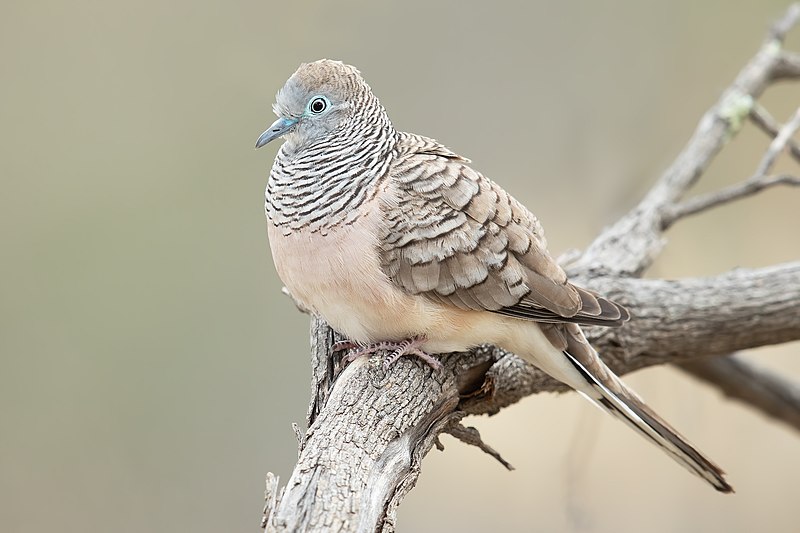
The Peaceful dove is a native bird of Australia and Papua New Guinea. It is a petite pigeon, ranging in size from 19 to 21 centimeters.
This bird belongs to the Geopelia family and is closely related to the Zebra dove of southeast Asia and the Barred dove of eastern Indonesia.
Although until recently, all three species were classified as a single species – Geopelia Striata. The peaceful dove, also known as the Zebra dove, is a peaceful bird with a gentle nature.
Due to their docile temperament, they are often kept as pets. Despite their small size, they are able to fly quickly and gracefully.
The colorful appearance of their feathers, mixed with their pleasant cooing sound, makes the Peaceful dove an enjoyable sight for bird watchers.
Scientific classification:
| Kingdom | Animalia |
| Phylum | Chordata |
| Class | Aves |
| Order | Columbiformes |
| Family | Columbidae |
| Genus | Geopelia |
| Species | G. placida |
37. Royal Spoonbill
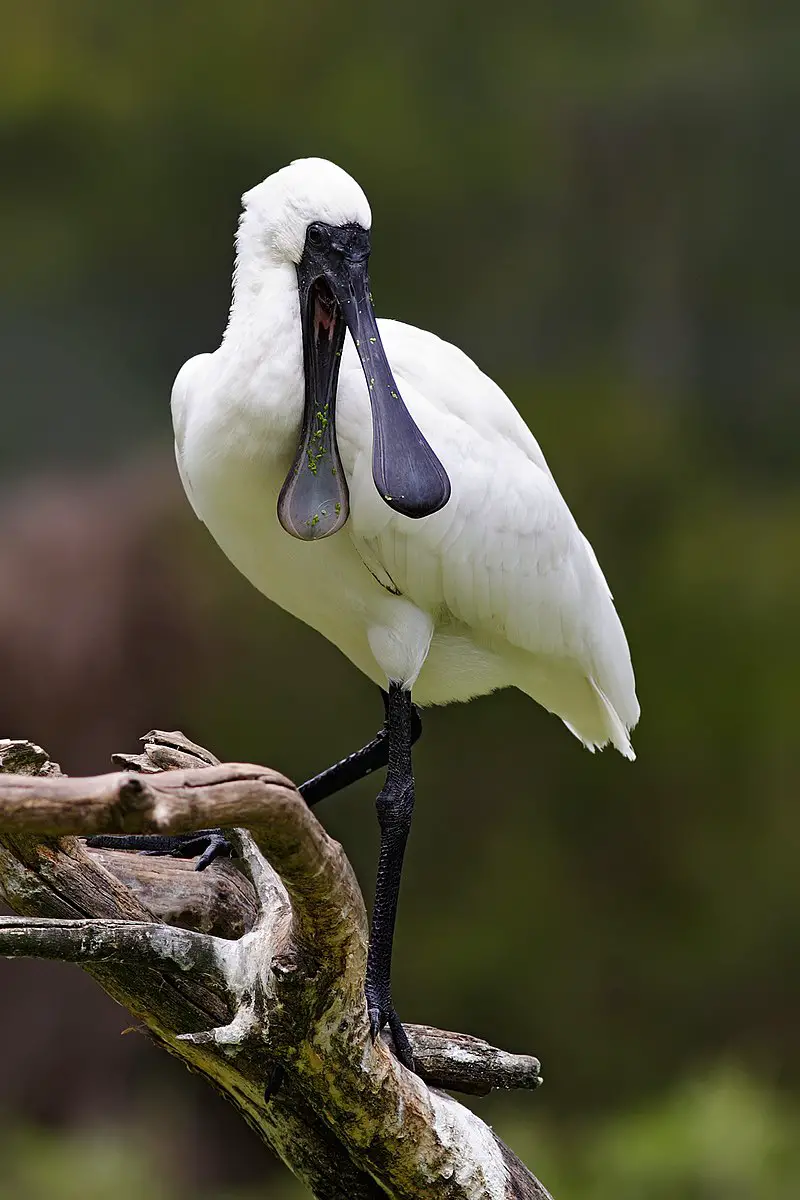
The royal spoonbill is a large bird found in wetlands across Australia, New Zealand, Papua New Guinea, and the Solomon Islands. Known for its distinctive spoon-shaped bill, it feeds on small fish, crustaceans, and insects in intertidal flats and shallow waters.
This black-billed spoonbill is also sometimes sighted as a vagrant in New Caledonia. In New Zealand, it is called kōtuku ngutupapa by the Māori people.
The royal spoonbill is often seen wading through water with its head bobbing back and forth as it searches for prey.
Its striking all-white plumage and bright yellow crest make it a popular sight for birdwatchers and nature enthusiasts.
The royal spoonbill is a fascinating bird, perfectly adapted to its aquatic habitat and always a delight to see in the wild.
Scientific classification:
| Kingdom | Animalia |
| Phylum | Chordata |
| Class | Aves |
| Order | Pelecaniformes |
| Family | Threskiornithidae |
| Genus | Platalea |
| Species | P. regia |
Also Featured In: Birds of New Caledonia,
38. Chestnut-Breasted Mannikin
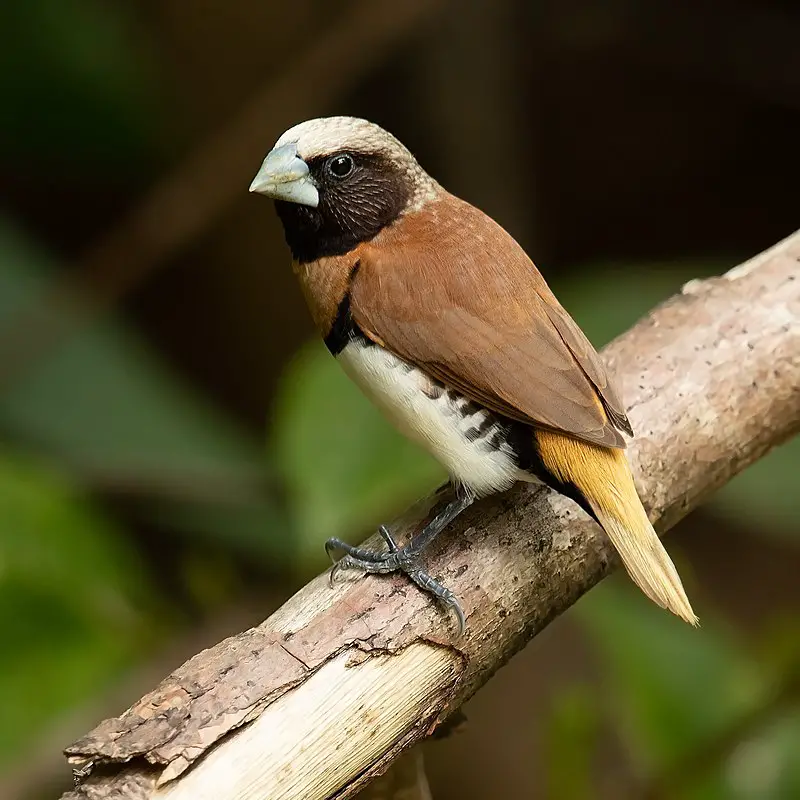
The chestnut-breasted mannikin, also called bully bird in Australia, is a small brown-backed munia with a black face and greyish crown and nape. It has a broad ferruginous breast bar on top of a white belly, making it a distinctive bird species.
The bird is found in various regions such as Australia, New Caledonia, Indonesia, and Papua New Guinea.
With its unique physical attributes and widespread habitat, the chestnut-breasted mannikin has caught the attention of birdwatchers around the world.
Its playful behavior and chirpy tweets make it a favorite companion among bird enthusiasts. Although this species has also been introduced to French Polynesia, it is primarily found in its natural range.
The chestnut-breasted mannikin is a charming bird, and its presence adds beauty to the diverse avian fauna of the world.
Scientific classification:
| Kingdom | Animalia |
| Phylum | Chordata |
| Class | Aves |
| Order | Passeriformes |
| Family | Estrildidae |
| Genus | Lonchura |
| Species | L. castaneothorax |
Also Featured In: Birds that Live in Tahiti Island,
39. Brown Honeyeater
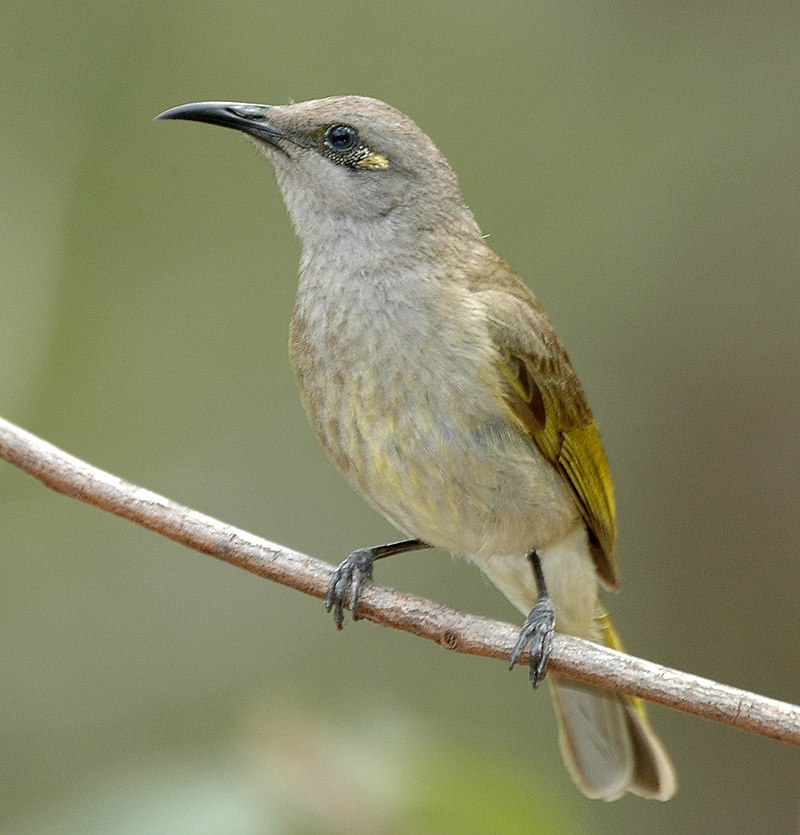
The brown honeyeater is a bird species belonging to the Meliphagidae family. With their brush-tipped tongues, they are adapted for nectar feeding. Honeyeaters are found mainly in Australia, New Guinea, and parts of Indonesia.
However, the brown honeyeater is unique in that it is also found on the island of Bali, making it the only honeyeater species to occur there.
The bird has brown plumage, which helps it to blend in with its surroundings, enabling it to evade detection by predators.
Brown honeyeaters feed on insects and nectar found in the flowers of various plant species. The species is known for its melodious calls and is a common sight in gardens, parks, and open woodlands.
Despite being widespread, the brown honeyeater is not considered endangered.
Scientific classification:
| Kingdom | Animalia |
| Phylum | Chordata |
| Class | Aves |
| Order | Passeriformes |
| Family | Meliphagidae |
| Genus | Lichmera |
| Species | L. indistincta |
Also Featured In: Common Birds of Lombok,
40. Grey Shrikethrush
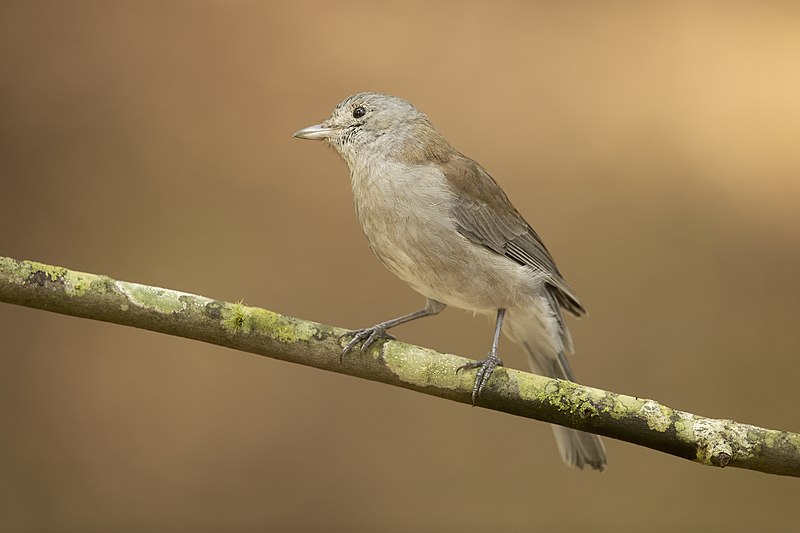
The grey shrikethrush, also known as the grey shrike-thrush or grey thrush, is a songbird native to Australasia. It can be found in most parts of Australia, but is absent from the driest areas of the inland deserts.
The bird is moderately common and is also found in New Guinea. It was originally classified under the genus Turdus.
The grey shrikethrush is often mistaken for the brown shrike-thrush due to similar appearance. They have a unique vocalization that consists of a series of melodious notes.
This bird is territorial and can be heard singing throughout the year, with peak breeding season being in August to December.
Despite being a common bird, certain regional populations have declined due to habitat destruction and fragmentation.
Scientific classification:
| Kingdom | Animalia |
| Phylum | Chordata |
| Class | Aves |
| Order | Passeriformes |
| Family | Pachycephalidae |
| Genus | Colluricincla |
| Species | C. harmonica |
Also Featured In: Birds that Live in Kangaroo Island,
41. Beach Stone-Curlew
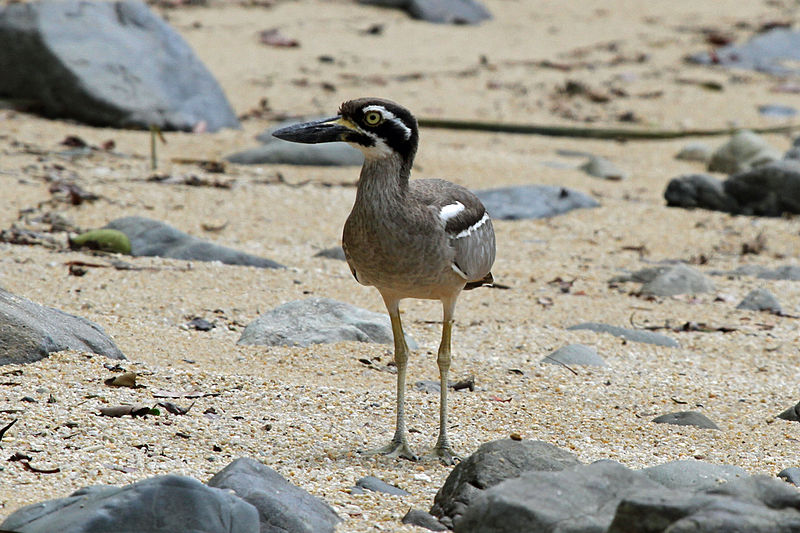
The beach stone-curlew is a large ground-dwelling bird found in Australasia and Southeast Asia. Weighing up to 1 kg, it is one of the largest shorebirds in the world.
With a distinct appearance, this bird has a sturdy body and long legs, making it well-suited for hunting on the beach.
The male species typically weighs a mean of 1,032 g, while the female species weighs around 1,000 g.
Its size and weight make it the heaviest living member of the Charadriiformes family outside of gulls.
The beach stone-curlew is also known as the beach thick-knee, owing to the distinctive thick joint on its leg.
This bird has become vulnerable to habitat loss and hunting, and conservation efforts have been initiated to protect the species.
Scientific classification:
| Kingdom | Animalia |
| Phylum | Chordata |
| Class | Aves |
| Order | Charadriiformes |
| Family | Burhinidae |
| Genus | Esacus |
| Species | E. magnirostris |
Also Featured In: Birds that Live in Gold Coasts,
42. Wandering Whistling Duck
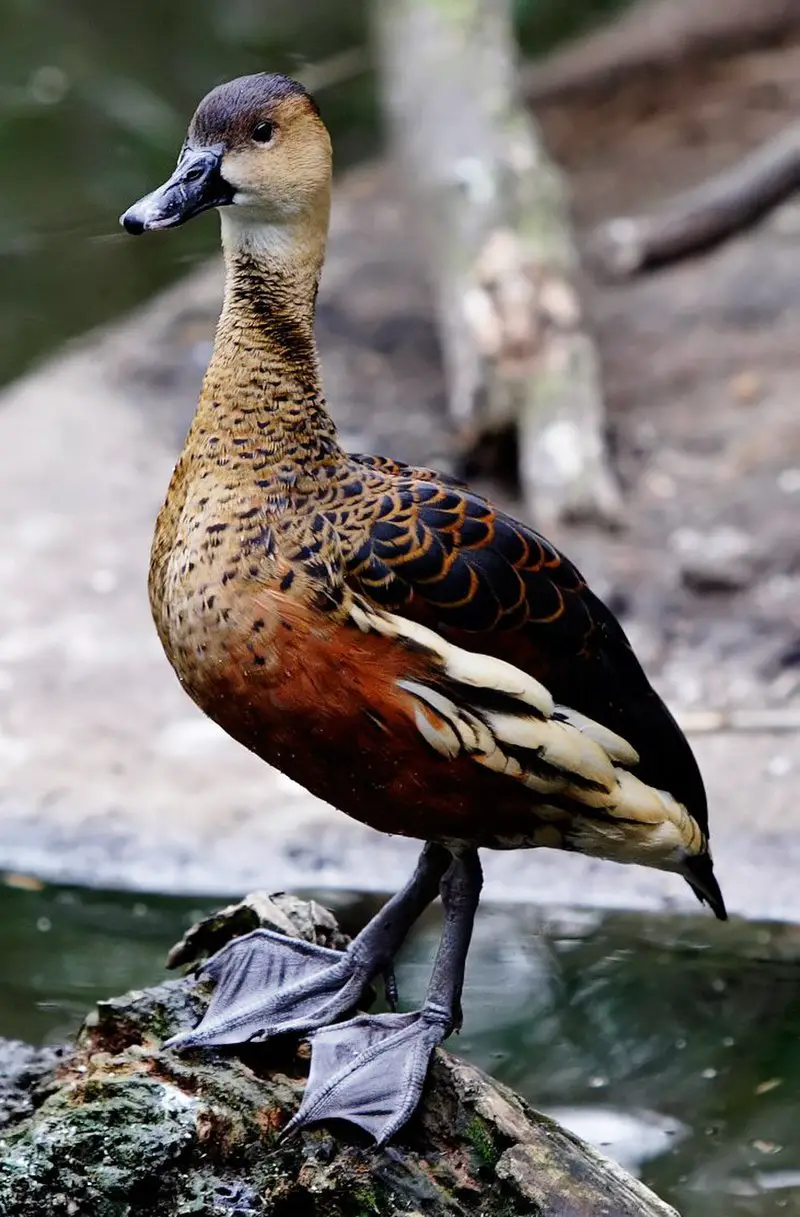
The Wandering whistling duck, also known as Dendrocygna arcuata, is a kind of whistling duck that is found in tropical and subtropical regions of several countries including Australia, the Philippines, Borneo, Indonesia, Papua New Guinea, and the Pacific Islands.
This bird has three subspecies – D. a. arcuata (Indonesian wandering whistling duck), D. a. australis (Australian wandering whistling duck) and D. a. pygmaea (New B).
It is known for its whistling calls that can be heard from a long distance. These ducks are known to feed on seeds, insects, and other small aquatic organisms.
They prefer living near wetlands, rivers, and lakes. The Wandering whistling duck is considered an important species due to its ecological and conservation value.
Scientific classification:
| Kingdom | Animalia |
| Phylum | Chordata |
| Class | Aves |
| Order | Anseriformes |
| Family | Anatidae |
| Genus | Dendrocygna |
| Species | D. arcuata |
43. Pacific Koel
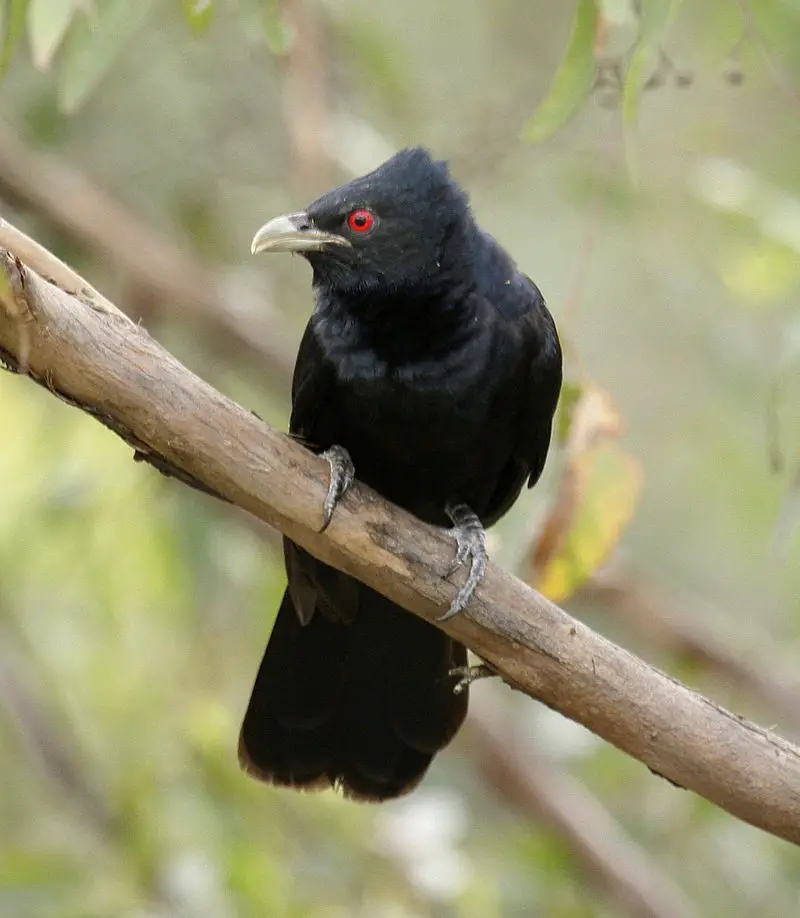
The Pacific koel, also known as the eastern koel, is a type of cuckoo bird belonging to the Cuculidae family. It is commonly heard in Australia where it is referred to as “rainbird” or “stormbird” due to its distinct call that is often heard before or during rainy weather.
While it was previously believed to be the same species as the Asian and black-billed koels, recent studies have shown that they are different.
The Pacific koel is known for its distinctive call and for being a seasonal visitor to Australia, where it is often heard during the summer months.
It is also known to be a brood parasite, laying its eggs in the nests of other birds for them to raise its young.
Despite its unusual behavior, the Pacific koel remains an interesting and mysterious bird that continues to fascinate bird enthusiasts around the world.
Scientific classification:
| Kingdom | Animalia |
| Phylum | Chordata |
| Class | Aves |
| Order | Cuculiformes |
| Family | Cuculidae |
| Genus | Eudynamys |
| Species | E. orientalis |
44. Radjah Shelduck
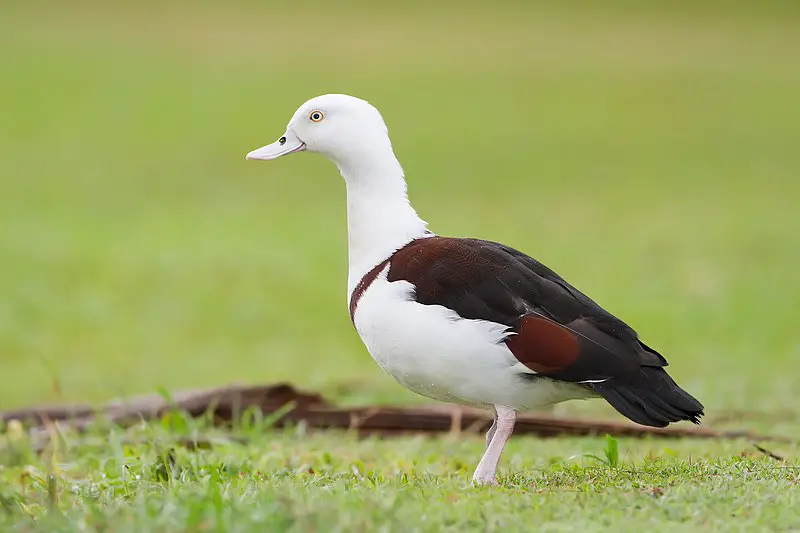
The Radjah shelduck is a unique bird species found mostly in New Guinea and Australia, as well as some of the Moluccas. It has several common names, such as raja shelduck, black-backed shelduck, and Burdekin duck in Australia.
The bird’s name, radjah, comes from the Moluccan people’s name for it on the island of Buru in Indonesia. This species was formerly classified in the genus Tad but is now considered a shelduck.
The Radjah shelduck possesses distinct physical features that set it apart from other waterfowl, including a black head and hindneck with a white throat and forehead.
It is a fascinating bird known for its unique calls and behaviors, which are specific to its habitat and environment.
The conservation status of the Radjah shelduck is currently of least concern as their populations are relatively stable.
Scientific classification:
| Kingdom | Animalia |
| Phylum | Chordata |
| Class | Aves |
| Order | Anseriformes |
| Family | Anatidae |
| Genus | Radjah Reichenbach, 1853 |
| Species | R. radjah |
45. Pacific Baza
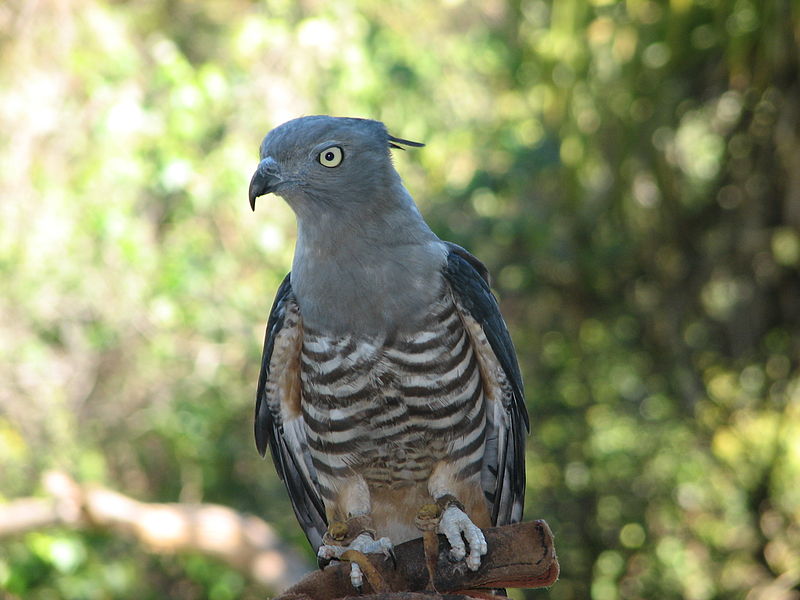
The Pacific baza is a medium-sized bird belonging to the Accipitridae family. It has a grey, brown, and white plumage and can grow up to 46 centimetres in length.
This species is an omnivore and does not typically migrate. Breeding season for the Pacific baza occurs from September to at least January. This bird is also known as the crested hawk, crested baza, and Pacific cuckoo-falcon.
Scientific classification:
| Kingdom | Animalia |
| Phylum | Chordata |
| Class | Aves |
| Order | Accipitriformes |
| Family | Accipitridae |
| Genus | Aviceda |
| Species | A. subcristata |
46. Latham’s Snipe
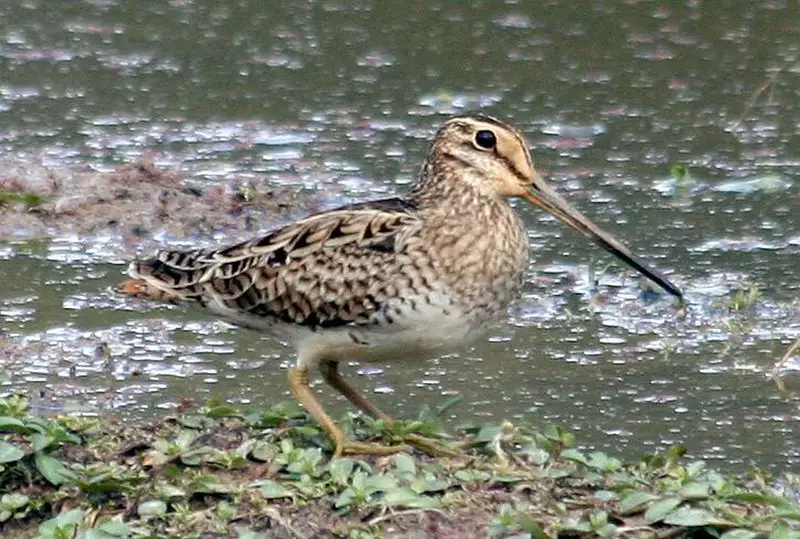
Latham’s snipe, also called the Japanese snipe, is a migratory bird found in the East Asian-Australasian Flyway. This medium-sized bird has a long bill that distinguishes it from other species.
The snipe’s plumage is a combination of black, brown, buff, and white, giving it a cryptic pattern. The bird is about 29-33 cm long, with a wingspan of 50-54 cm, and weighs between 150-230 g.
Despite being identifiable as a Gallinago snipe, it is challenging to distinguish it from Swinhoe’s snipe.
As a migratory species, the Latham’s snipe travels to different regions to breed and feed.
The breeding area is located in East Asia, while the non-breeding place is found in Southeast Asia and Australia. This bird species relies mainly on wetland habitats to thrive and survive.
Scientific classification:
| Kingdom | Animalia |
| Phylum | Chordata |
| Class | Aves |
| Order | Charadriiformes |
| Family | Scolopacidae |
| Genus | Gallinago |
| Species | G. hardwickii |
Also Featured In: Common Birds of Sapporo, Birds Commonly Found in Kyoto
47. Mangrove Honeyeater
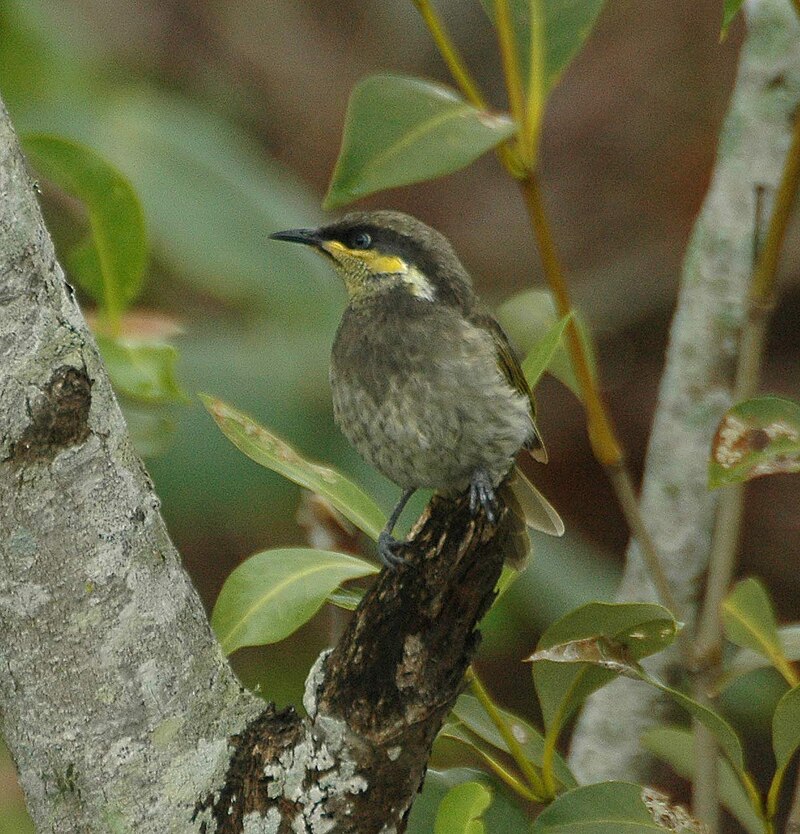
The Mangrove honeyeater is a bird native to Eastern Australia. It is part of the Meliphagidae family and was once believed to be the same species as the varied honeyeater.
However, it is now recognized as a separate species. Along with the varied honeyeater and singing honeyeater, it forms a unique genus. Despite its name, the Mangrove honeyeater is not limited to mangrove habitats and can be found in a variety of coastal environments.
Its diet consists mainly of insects and nectar, which it obtains while foraging in vegetation. The bird appears to be in good health and is not currently considered to be at risk of extinction. Overall, the Mangrove honeyeater is an interesting and important part of the Australian avian ecosystem.
Scientific classification:
| Kingdom | Animalia |
| Phylum | Chordata |
| Class | Aves |
| Order | Passeriformes |
| Family | Meliphagidae |
| Genus | Gavicalis |
| Species | G. fasciogularis |
48. Mangrove Gerygone
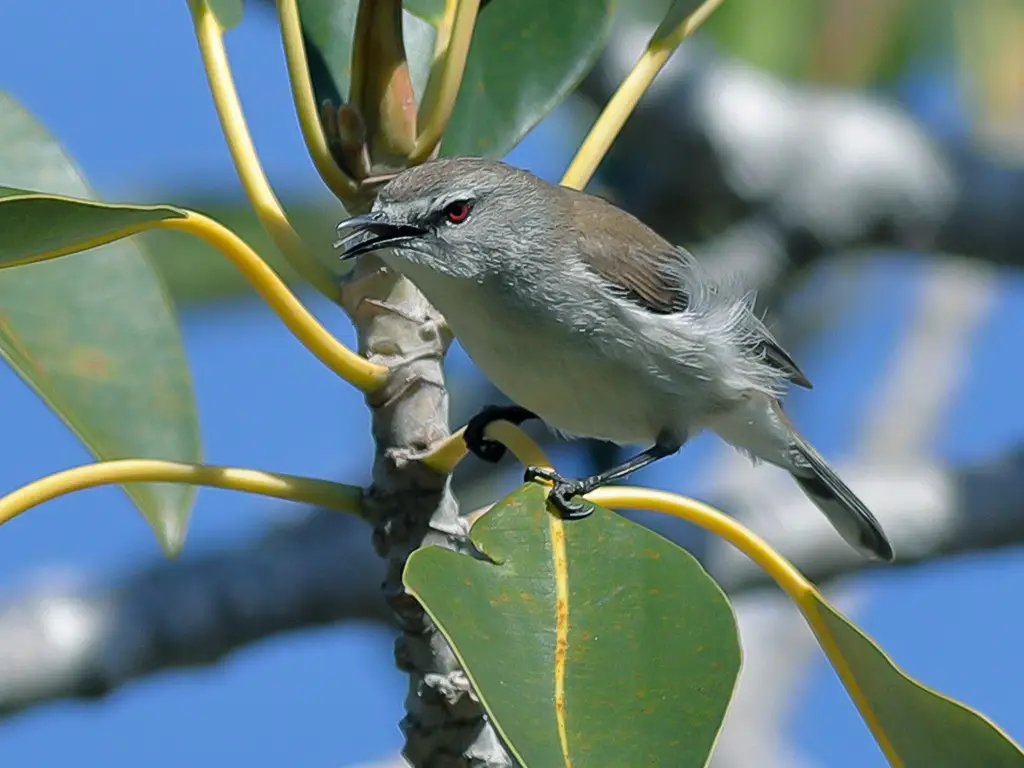
The Mangrove gerygone, or Mangrove warbler, is a species of bird belonging to the Australian warbler family Acanthizidae. It is related to the fan-tailed gerygone found in Melanesia and the Australian western gerygone.
This bird is found in southern New Guinea and has three subspecies, known as G. l. pallida. The Mangrove gerygone bird is known for its unique, melodic bird song and is often found in coastal areas, particularly in mangrove forests.
These birds have a distinctive olive-brown coloration and are small in size, reaching only around 10 centimeters in length. They are typically active and agile, flitting in and out of the dense foliage in search of insects and other small prey.
Despite their small size, they are an important part of the ecosystem and play a key role in the food chain.
Scientific classification:
| Kingdom | Animalia |
| Phylum | Chordata |
| Class | Aves |
| Order | Passeriformes |
| Family | Acanthizidae |
| Genus | Gerygone |
| Species | G. levigaster |
49. Black-Backed Bittern
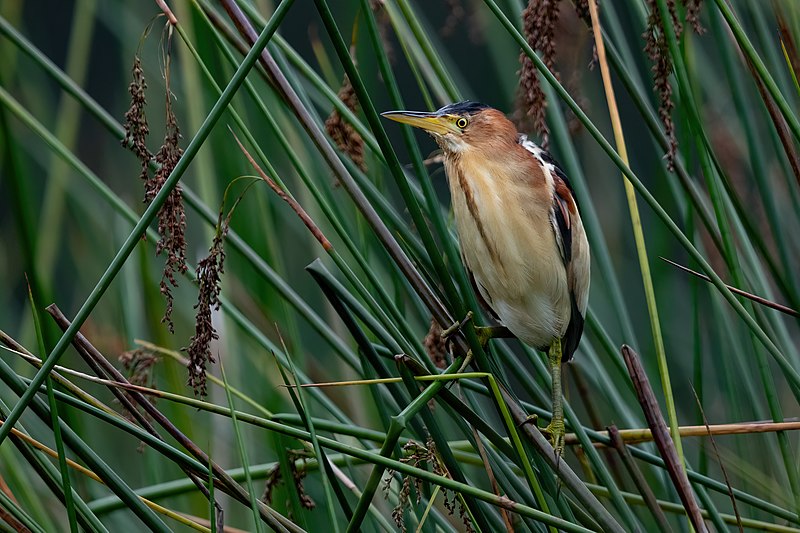
The Black-backed Bittern is a species of heron that can be found in Australia and occasionally in southern New Guinea. It is part of the Ardeidae family and is one of the smallest herons in the world.
Often grouped with the Little Bittern, it is also known as the Black-backed Least Bittern or Australian Little Bittern. Despite its small size, this little-known bird is a skilled hunter and feeds on small fish, frogs, and insects.
Its distinctive appearance includes a black back and cap, white underparts, and a long slender bill. Due to its elusive nature, the Black-backed Bittern is not commonly observed by humans, making it a treasured sight for birdwatchers.
Scientific classification:
| Kingdom | Animalia |
| Phylum | Chordata |
| Class | Aves |
| Order | Pelecaniformes |
| Family | Ardeidae |
| Genus | Ixobrychus |
| Species | I. dubius |
50. Lemon-Bellied Flyrobin
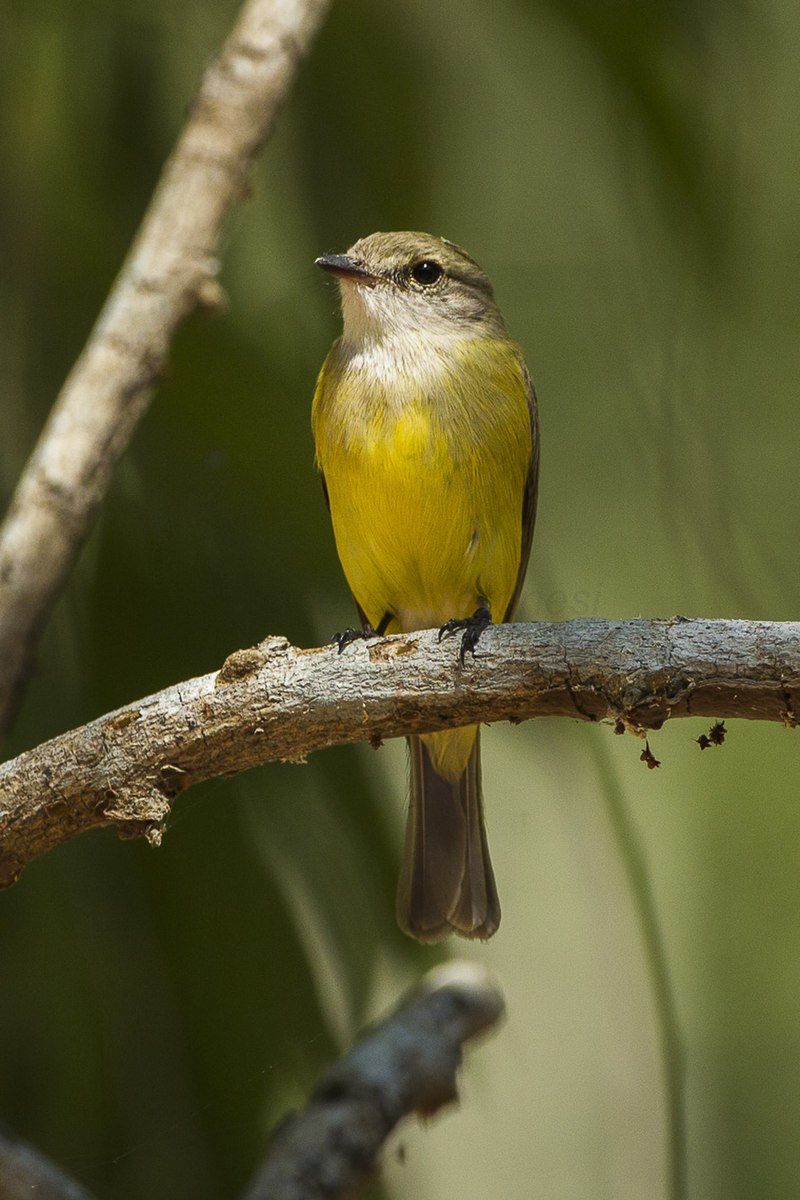
The lemon-bellied flyrobin, also known as lemon-bellied flycatcher, is a bird belonging to the Petroicidae family. This species can be found in Australia, Indonesia, and Papua New Guinea where it inhabits subtropical or tropical forests, as well as mangrove forests.
It was first described by John Gould in 1843 using a specimen collected from Port Essington located in the Northern Territory. This bird is known for its distinctive lemon-yellow belly and olive-brown upperparts.
It feeds on insects and other small invertebrates using a sit-and-wait hunting technique, perching on a low branch and flying out to catch its prey.
Despite, there is little information available about the conservation status of this species, it is believed that they are not currently at risk.
Scientific classification:
| Kingdom | Animalia |
| Phylum | Chordata |
| Class | Aves |
| Order | Passeriformes |
| Family | Petroicidae |
| Genus | Microeca |
| Species | M. flavigaster |
51. Brown Gerygone
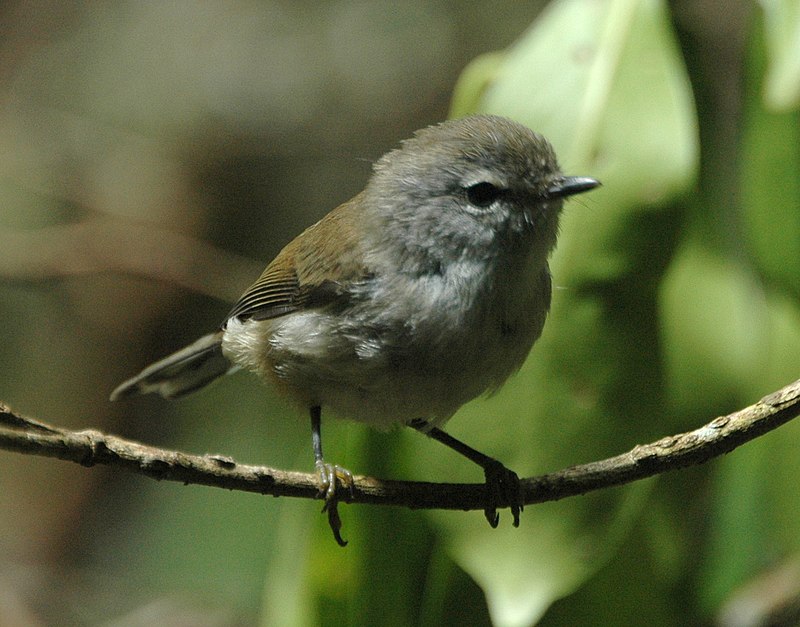
The Brown Gerygone bird can be found in eastern coastal Australia. It measures around 10cm and has deep olive-grey or olive-brown upper parts and a paler grey, cream, or washed-out brown face and underparts.
Its tail feathers are dark and may have white tips. This small passerine bird, formerly called the Brown Warbler, has a distinct appearance due to its unique coloring.
In the wild, they are known to reside in forests, woodlands, and wetlands, and it is not uncommon to find them foraging for insects in tree canopies.
Despite their small size, the Brown Gerygone birds are known to produce a remarkable song. This song is characterized by a high-pitched, clear, and melodious sound, making them an interesting subject for bird-watchers and nature enthusiasts.
Scientific classification:
| Kingdom | Animalia |
| Phylum | Chordata |
| Class | Aves |
| Order | Passeriformes |
| Family | Acanthizidae |
| Genus | Gerygone |
| Species | G. mouki |